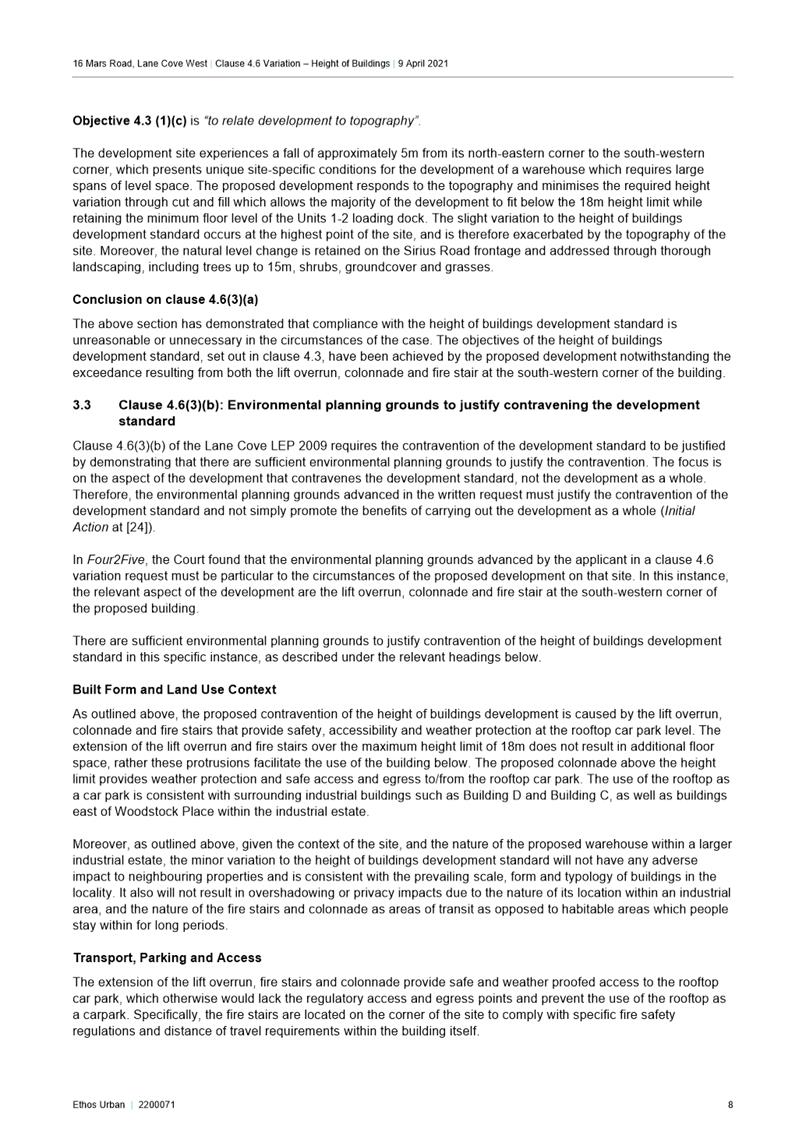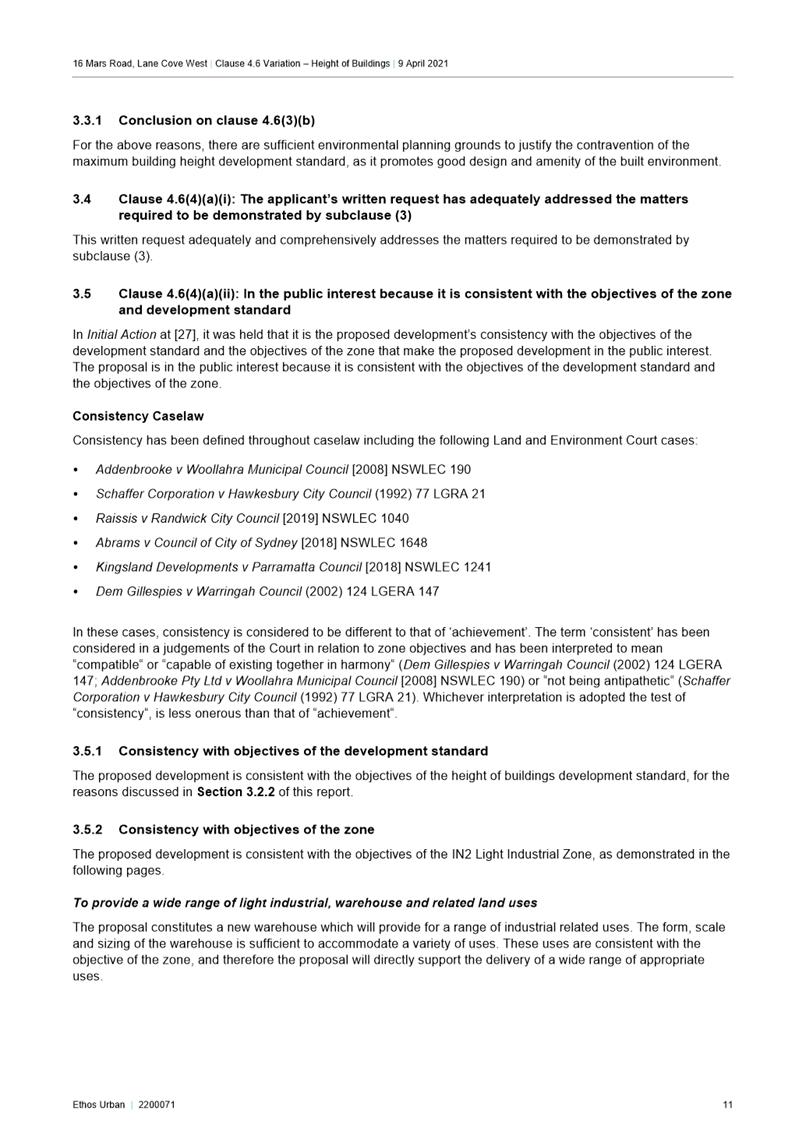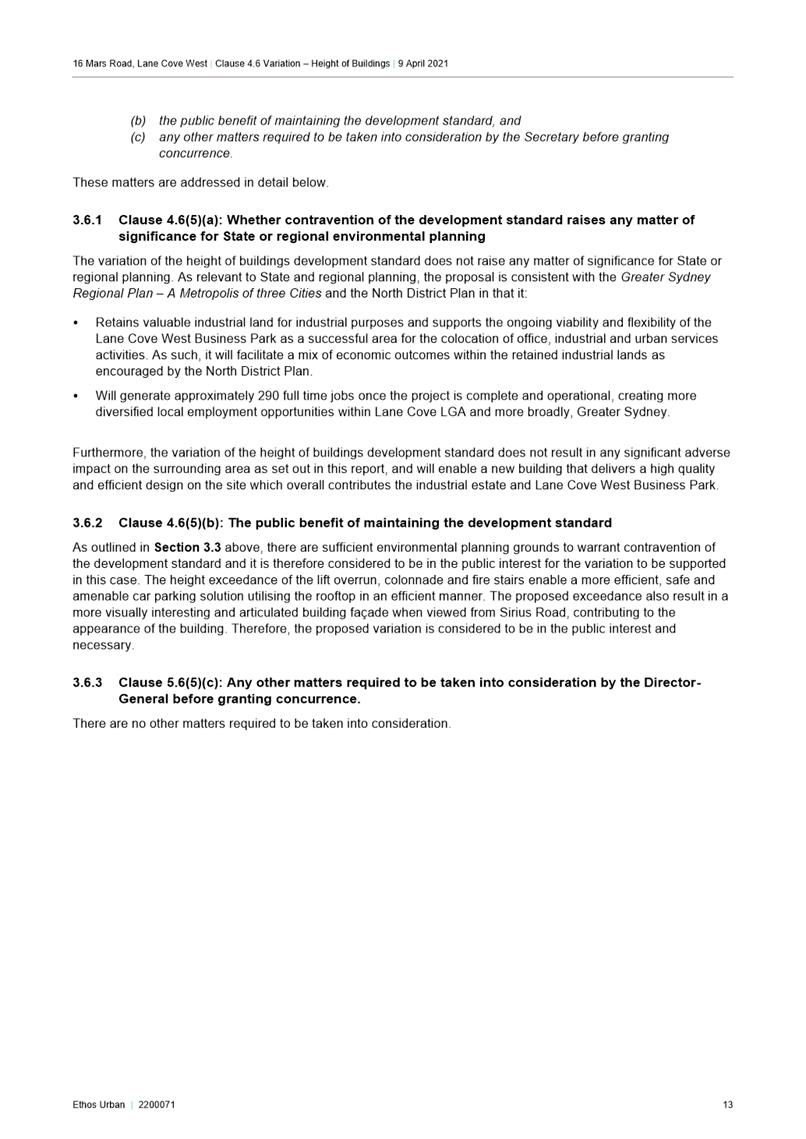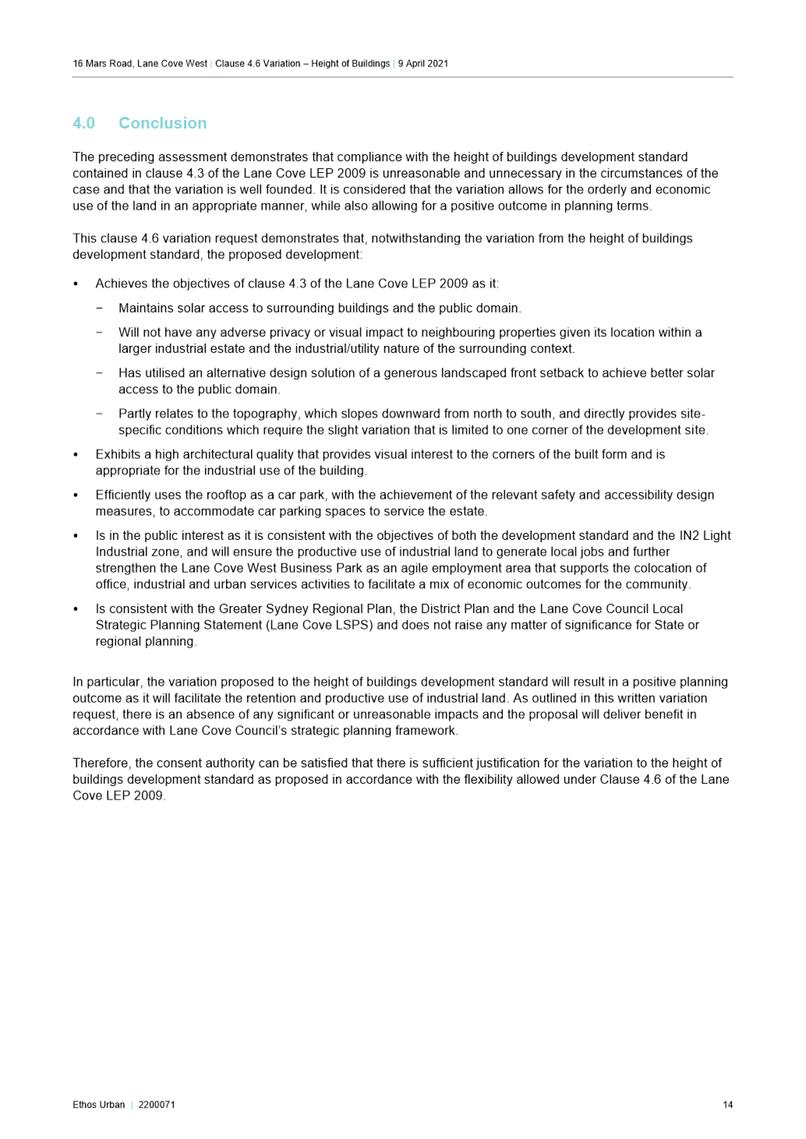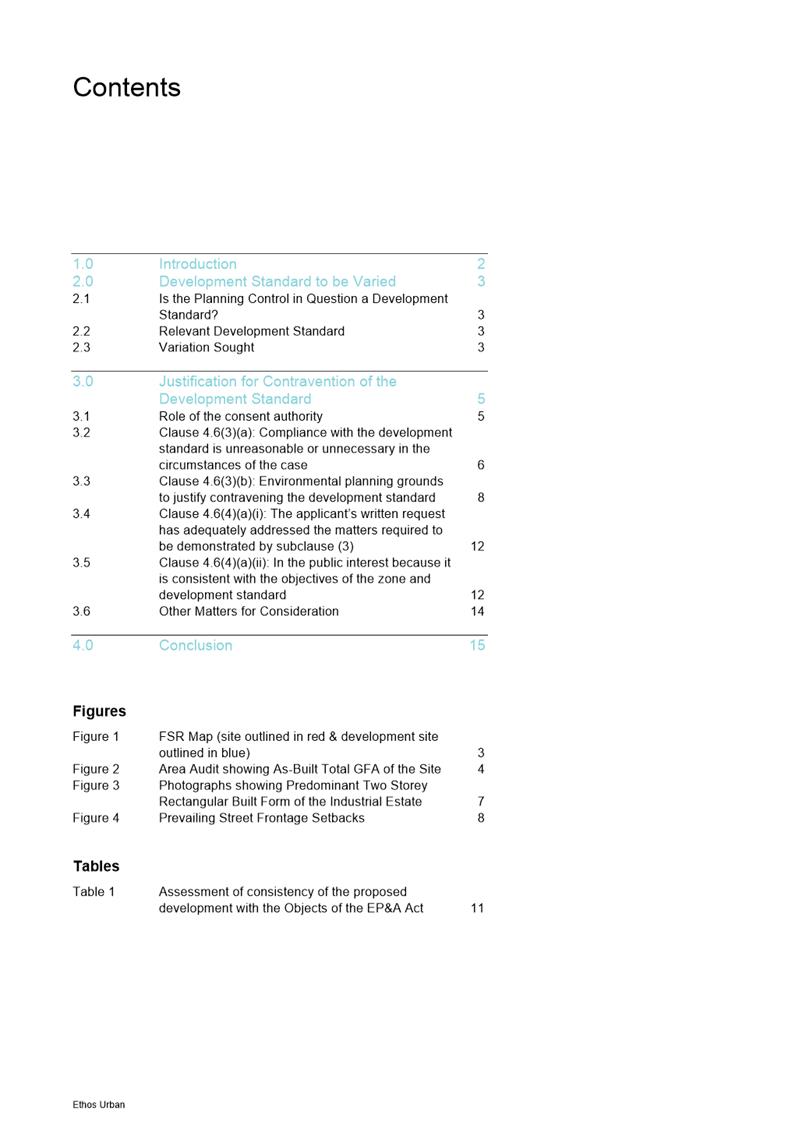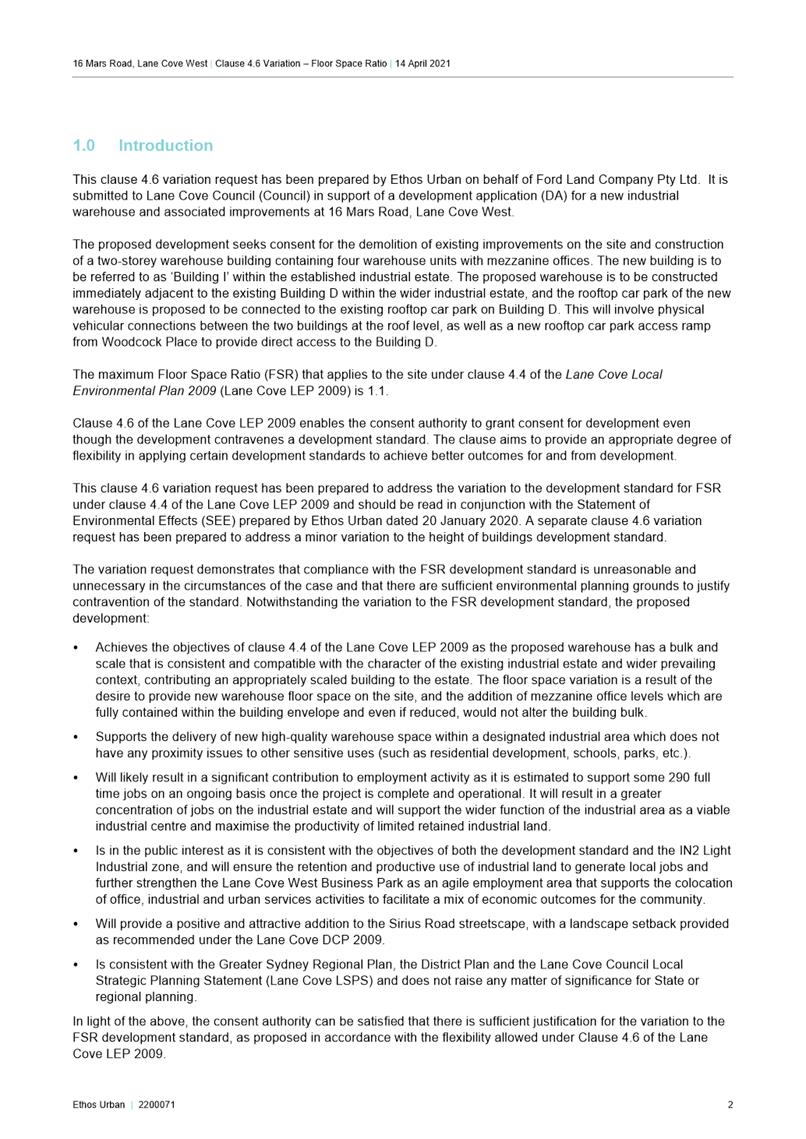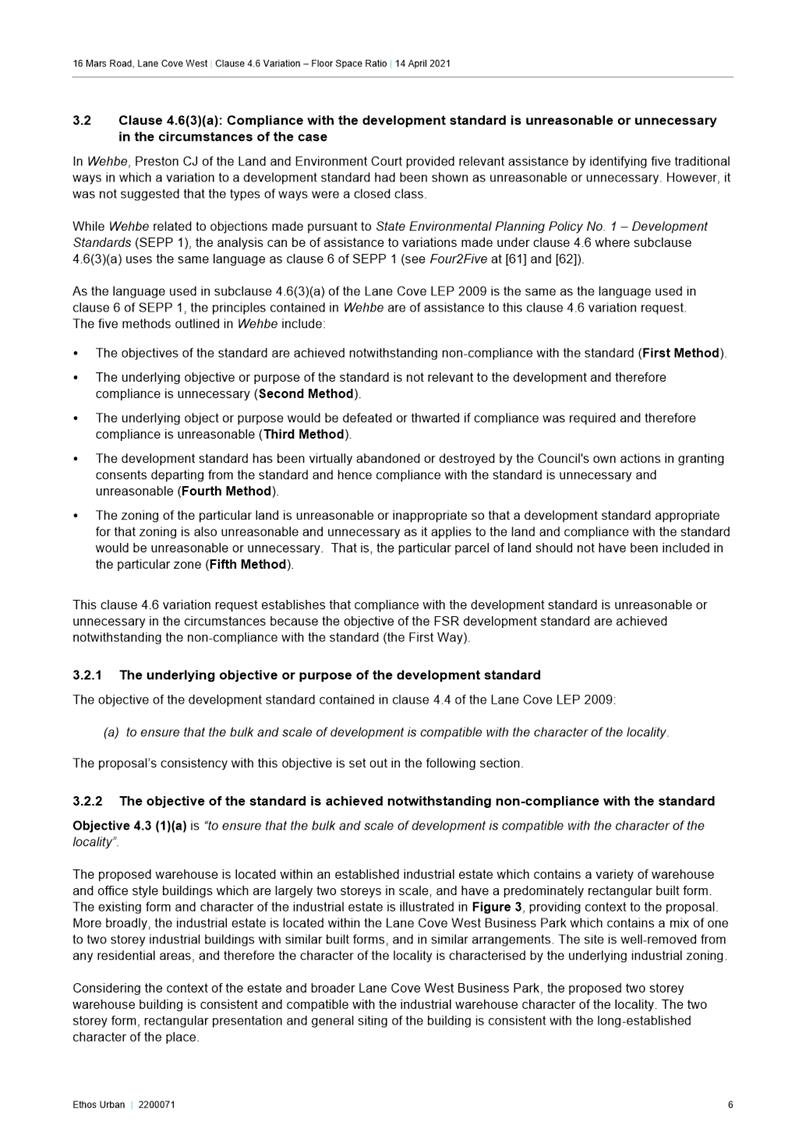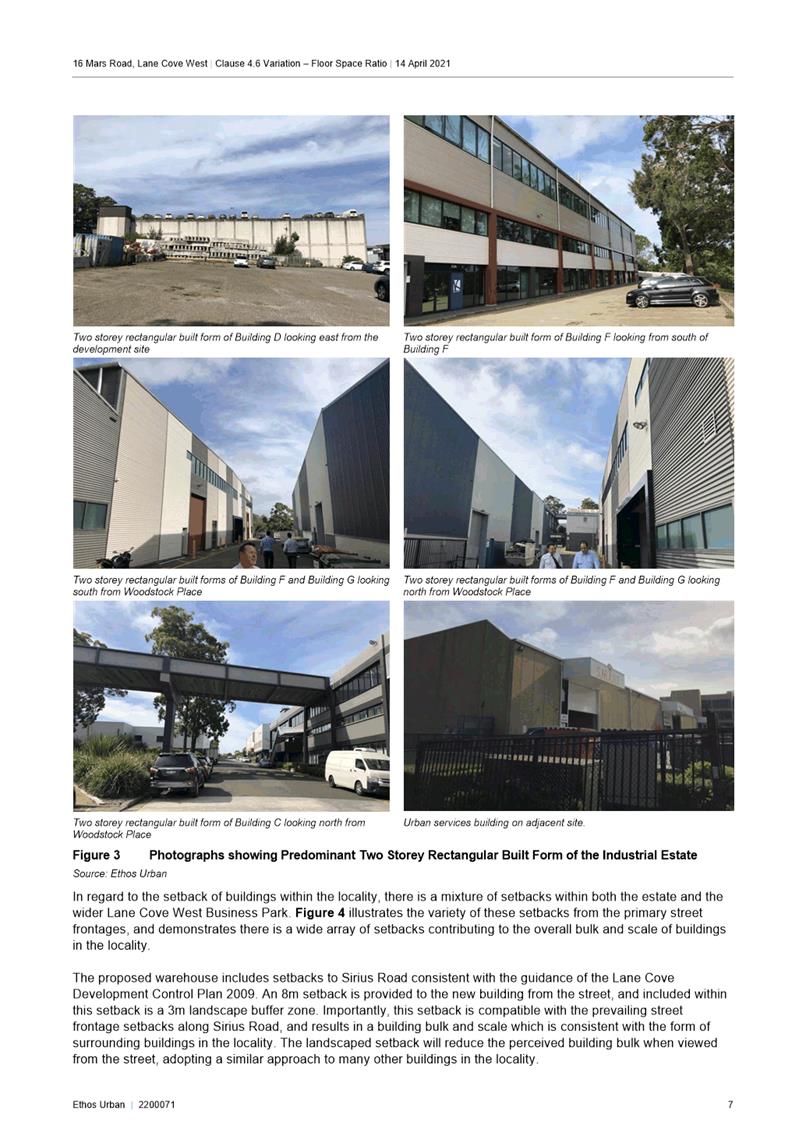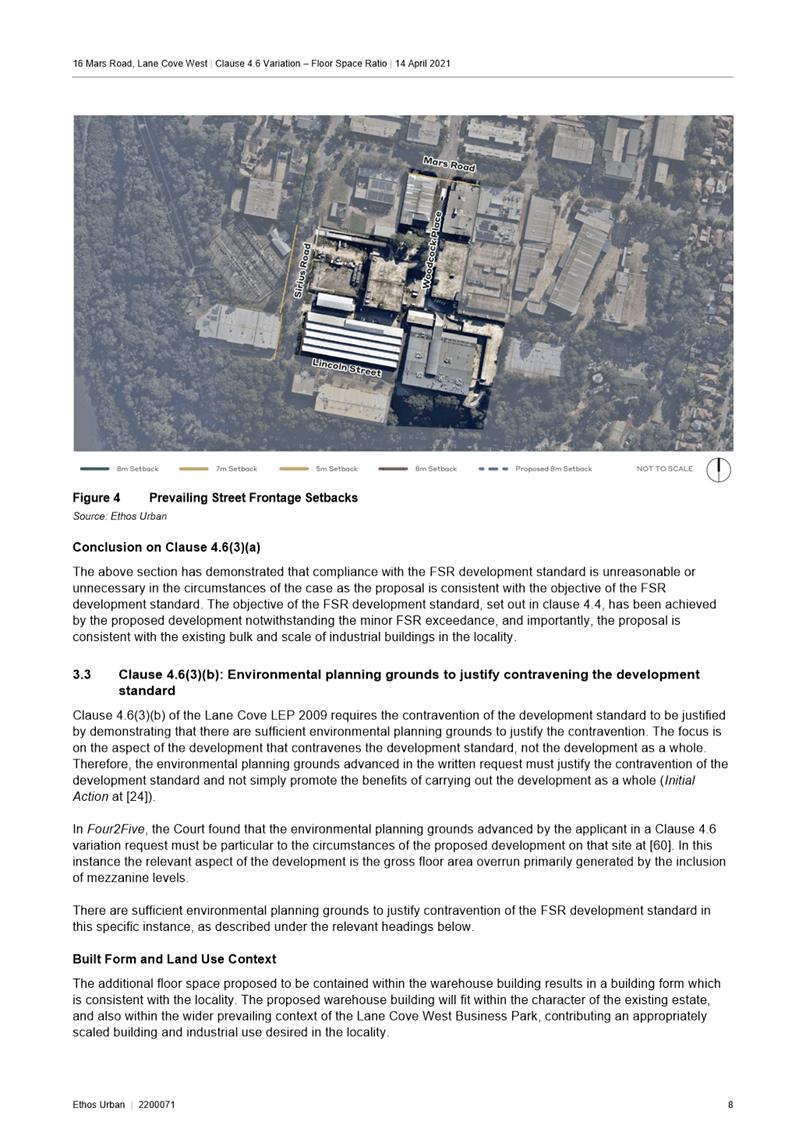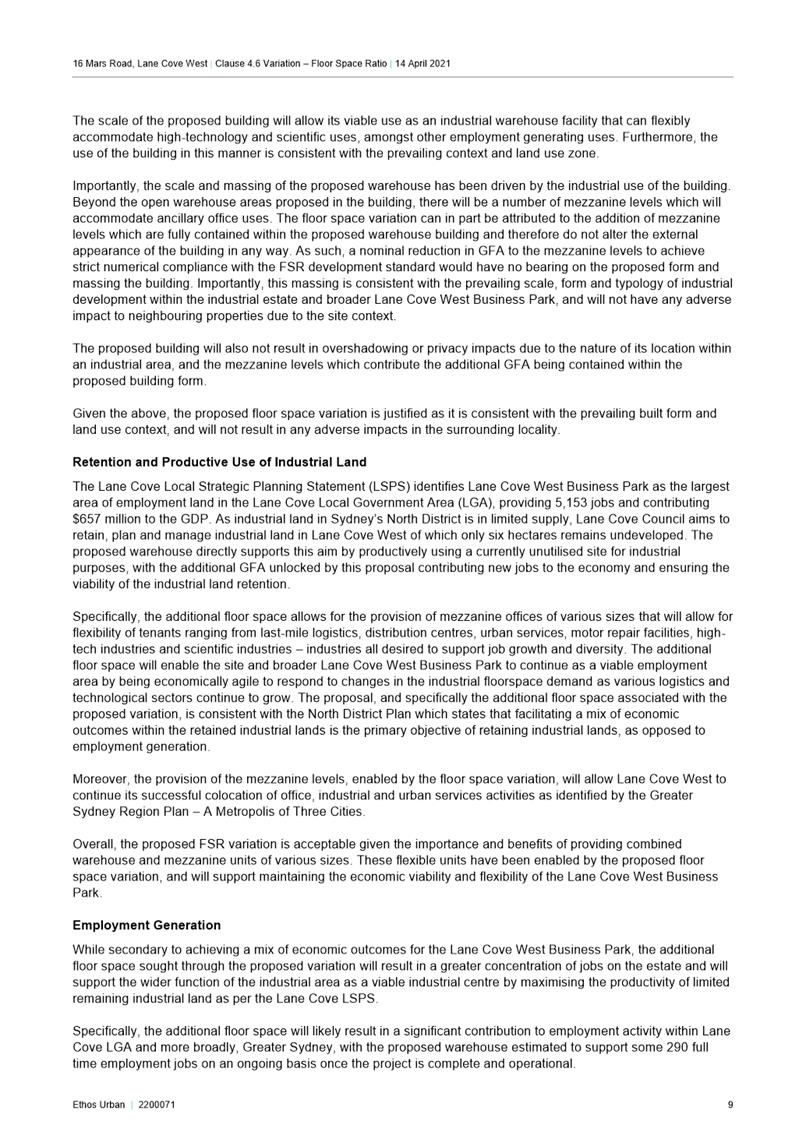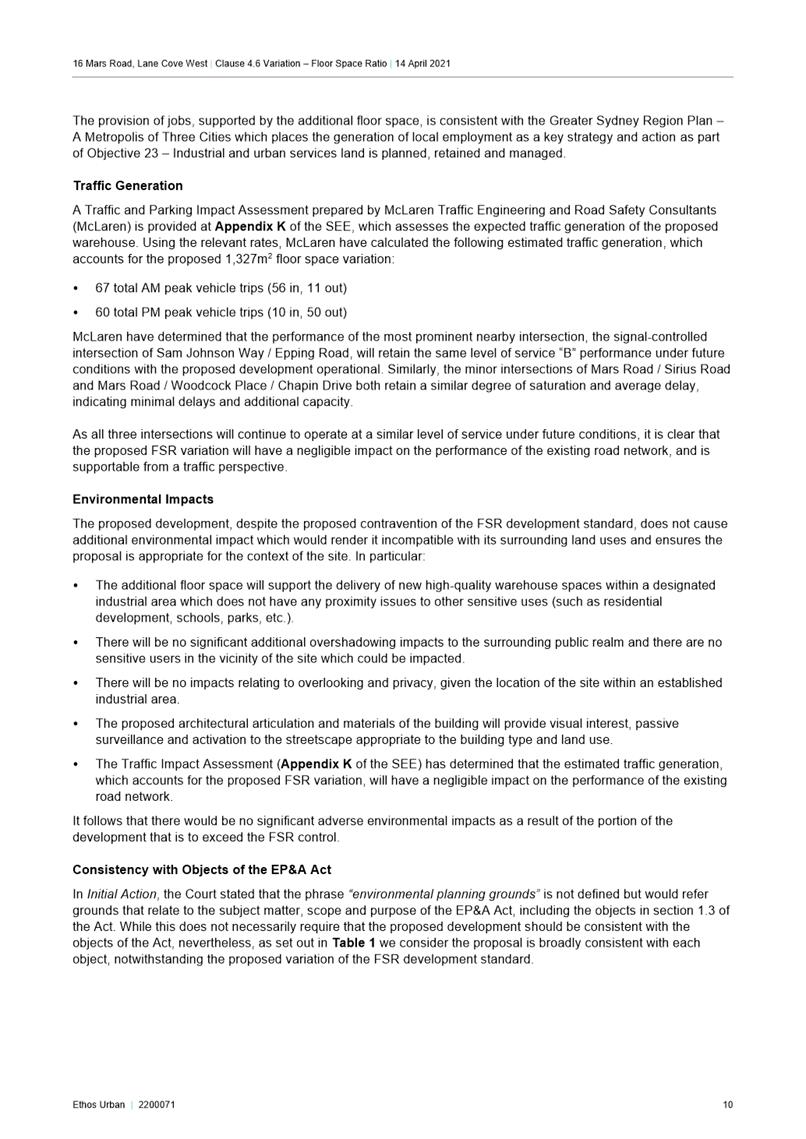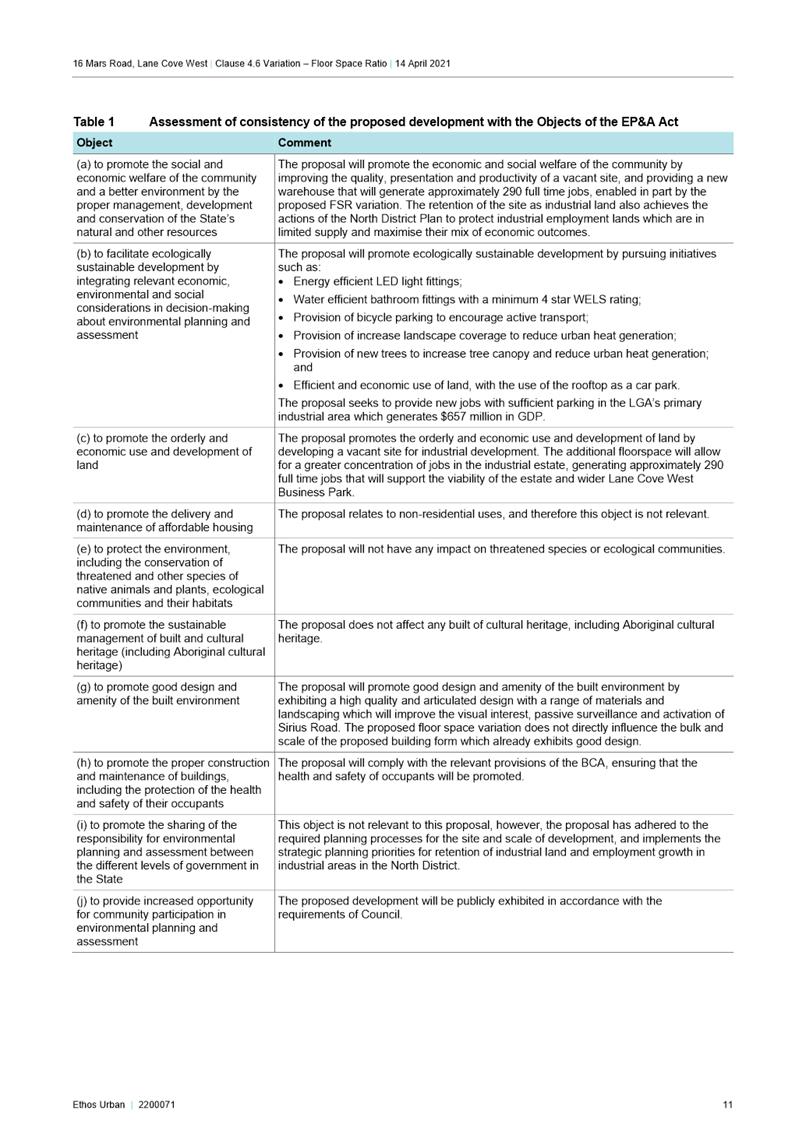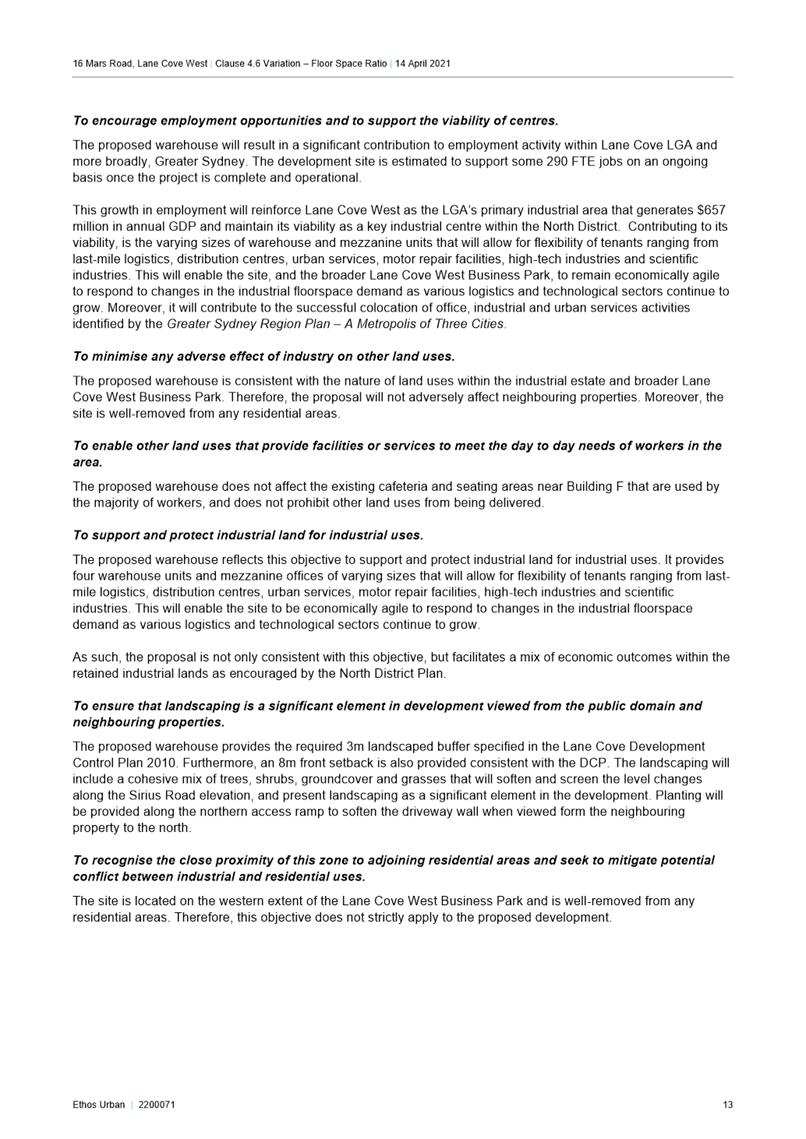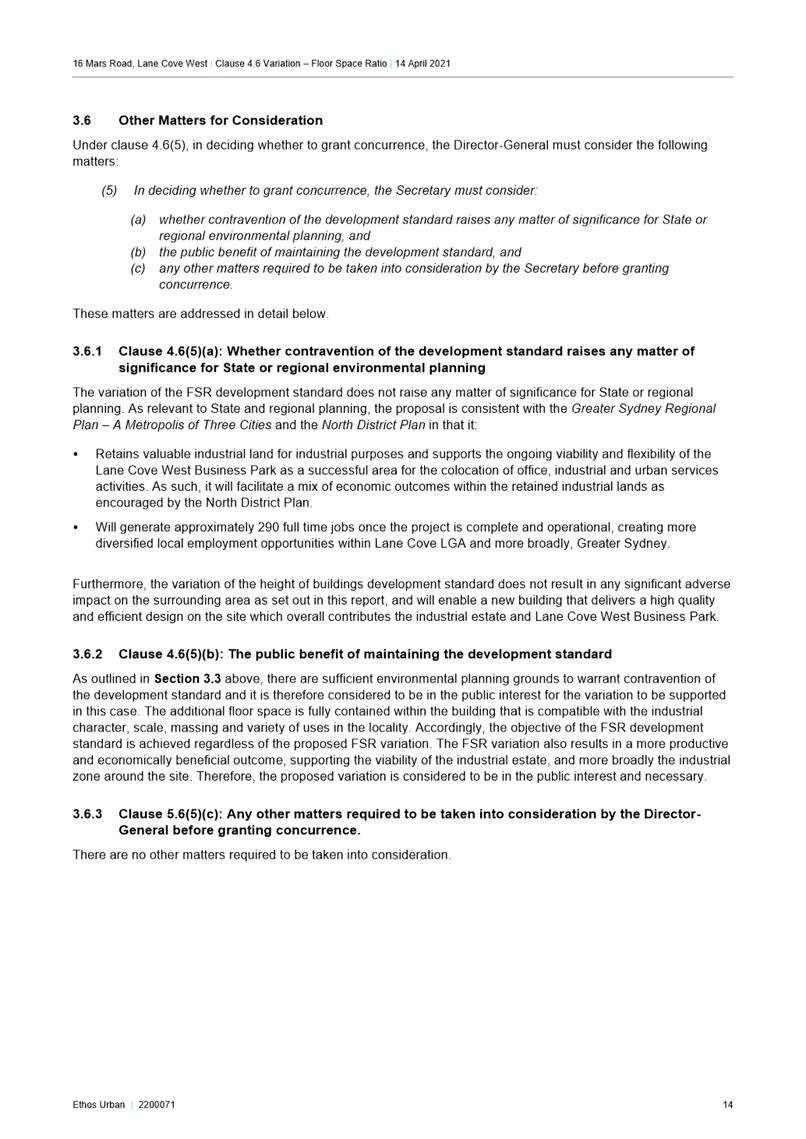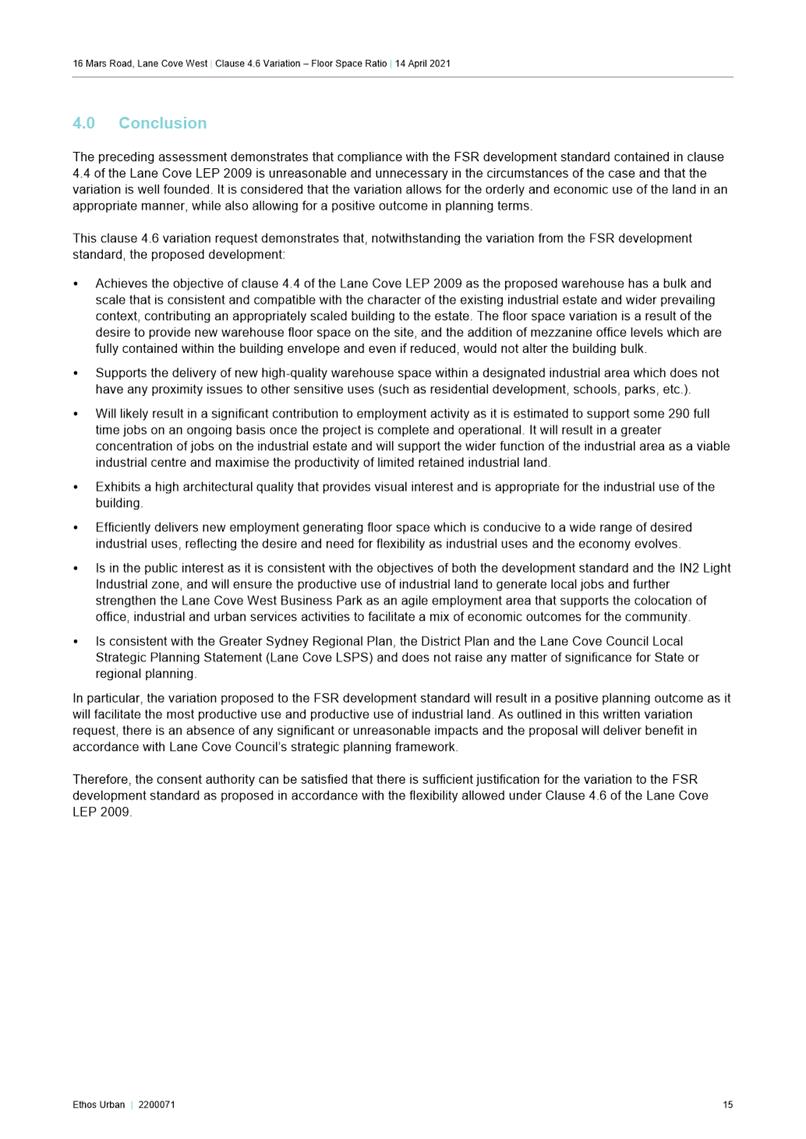|
RECOMMENDATION
That the Lane Cove Planning
Panel approve the proposed variations to the Building Height and FSR
development standards in Clause 4.3(2) & 4.4(2) in Lane Cove Local
Environmental Plan 2009, as the applicant’s written request does
adequately address the matters required to be demonstrated. The proposed
development would be in the public interest because it is consistent with the
objectives of the particular standards, the objectives for development in the
zone and there are sufficient environmental planning grounds to justify the
variations.
The Lane Cove Local Planning Panel, in exercising its duties as
the consent authority, pursuant to Section 4.16(1)(b) of the
Environmental Planning and Assessment Act 1979, approve
the subject Development Application DA43/2021 for the warehouse building
development on land at No. 16 Mars Road Lane Cove West subject to the
following conditions:-
1. That
the development be strictly in accordance with Drawing Nos. DA100, 200 &
202 Revision 11, DA204 Issue 10 dated 15.06.21, DA203 & 300 Issue 10,
DA101 Issue 1, DA201, 400 & 601-602 Issue 9, DA603 Issue 5 dated 16.03.21
prepared by SBA Architects and L-01-05E dated 29/07/21 prepared by
SiteDesign+Studios.
except as amended by the following conditions.
In
the event of any inconsistency between the approved plans and the supporting
documentation, the approved plans prevail. Note: an inconsistency
occurs between an approved plan and supporting documentation or between an
approved plan and a condition
when it is not possible to comply with both at the relevant time.
Reason: To ensure all parties are aware of the
approved plans and supporting
documentation that applies to the development.
2. No
external cladding is permitted.
3.
The hours of operation on the development are restricted to the following:-
Monday to Friday (inclusive) 5.30am
to 9pm
Saturday to Sunday
5.30am to 5pm
No work to be carried out on any public holidays.
4. The
submission of a Construction Certificate and its issue by Council or
Principal Certifier PRIOR TO CONSTRUCTION WORK commencing.
5. All
building works are required to be carried out in accordance with the
provisions of the Building Code of Australia.
A
Completion Certificate is to be issued by either the Principal Certifier or a
qualified accredited Fire Safety Engineer, confirming that all identified
Performance Solutions have been completed for the building PRIOR TO THE ISSUE
OF A FINAL OCCUPATION CERTIFICATE.
6. The approved plans must be submitted to Sydney
Water online approval portal “Sydney Water Tap In”, please
refer to web site www.sydneywater.com.au.
This is to determine whether the development will affect Sydney Water’s
sewer and water mains, stormwater drains and/or easements, and if further
requirements need to be met. An approval receipt with conditions shall be
issued by Sydney Water (if determined to be satisfactory) and is to be
submitted to the accredited certifier prior to the issue of a Construction
Certificate.
7. An
Occupation Certificate being obtained from the Principal Certifier before the
occupation of the building.
8. A
Section 73 Compliance Certificate under the Sydney Water Act 1994 must be
obtained from Sydney Water Corporation.
Application
must be made through an authorised Water Servicing Coordinator. Please
refer to the “Your Business” section of the web site www.sydneywater.com.au
then follow the “e-Developer” icon or telephone 13 20 92 for
assistance.
Following
application a “Notice of Requirements” will advise of water and
sewer extensions to be built and charges to be paid. Please make early
contact with the Co-ordinator, since building of water/sewer extensions can
be time consuming and may impact on other services and building, driveway or
landscape design.
The
Section 73 Certificate must be submitted to the Principal Certifier prior to
occupation of the development/release of the plan of subdivision.
9. All
demolition, building construction work, including earthworks, deliveries of
building materials to and from the site to be restricted as follows:-
Monday to Friday
(inclusive) 7am to 5.30pm High noise generating
activities, including rock breaking and saw cutting must not be
carried out continuously for longer than 3 hours without a 1 hour break.
Saturday 8am
to 12 noon with NO excavation, haulage truck movement, rock picking,
sawing, jack hammering or pile driving to be undertaken. Failure to
fully comply will result in the issue of a breach of consent P.I.N.
Sunday No work Sunday or any Public
Holiday.
A Notice/Sign showing permitted working hours and
types of work permitted during those hours, including the applicant’s
phone number, project manager or site foreman, shall be displayed at the
front of the site.
10. Stockpiles
of topsoil, sand, aggregate, spoil or other material capable of being moved
by water to be stored clear of any drainage line, easement, natural
watercourse, footpath, kerb or roadside.
11. The
development shall be conducted in such a manner so as not to interfere with
the amenity of the neighbourhood in respect of noise, vibration, smell, dust,
waste water, waste products or otherwise.
12. No
goods or waste being stored externally to any warehouse unit.
13. Depositing
or storage of builder's materials on the footpath or roadways within the
Municipality without first obtaining approval of Council is PROHIBITED.
Separate approval must be obtained from Council's Works and Urban
Services Department PRIOR TO THE PLACEMENT of any building waste container
("Skip") in a public place.
14. Prior
to the commencement of any construction work associated with the development,
the Applicant shall erect a sign(s) at the construction site and in a
prominent position at the site boundary where the sign can be viewed from the
nearest public place. The sign(s) shall indicate:
a) the name, address
and telephone number of the Principal Certifier;
b) the name of the
person in charge of the construction site and telephone number at which that
person may be contacted outside working hours; and
c) a statement that
unauthorised entry to the construction site is prohibited.
The signs shall be maintained for the duration of
construction works.
15. The
cleaning out of ready-mix concrete trucks, wheelbarrows and the like into
Council's gutter is PROHIBITED.
16. Where
Lane Cove Council is appointed as the Principal Certifier, it will be
necessary to book an inspection for each of the following stages during the
construction process. Forty eight (48) hours notice must be given prior
to the inspection being required:-
a) All
reinforcement prior to filling with concrete.
b) Framework
including roof and floor members when completed and prior to covering.
c) Installation of
steel beams and columns prior to covering.
d) Waterproofing
of wet areas.
e) Stormwater
drainage lines prior to backfilling.
f) Completion.
17. Structural
Engineer's details being submitted PRIOR TO ISSUE OF CONSTRUCTION CERTIFICATE
for the following:-
b) retaining
walls;
c) footings;
d) reinforced concrete
work;
e) structural
steelwork;
f) framing.
18. A
check survey certificate is to be submitted at the completion of:-
a. The completion
of works.
Note: All levels are to relate to the reduced levels
as noted on the approved architectural plans and should be cross-referenced
to Australian Height Datum.
19. The
removal, handling and disposal of asbestos from building sites being carried
out in accordance with the requirements of the Occupational Health and Safety
Act and the Regulations. Details of the method of removal to be
submitted PRIOR TO COMMENCING ANY DEMOLITION WORKS.
20. The
demolition works being confined within the boundaries of the site.
21. All
spillage deposited on the footpaths or roadways to be removed at the
completion of each days work.
22. The
site being properly fenced to prevent access of unauthorised persons outside
of working hours.
23. Compliance
with Australian Standard 2601 - The Demolition of Structures.
24. An
approved type of hoarding being erected along the street frontage.
25. Compliance
with the Waste Management Plan submitted along with the application.
26. It should
be understood that this consent in no way relieves the owners or applicant
from any obligation to obtain any other approval which may be required under
any covenant affecting the land or otherwise nor relieve a person from the
legal civil consequences of not complying with any such covenant.
27. Long Service Levy Compliance
with Section 6.8 of the Environmental Planning and Assessment Act 1979;
payment of the Long Service Levy payable under Section 34 of the Building and
Construction Industry Long Service Payments Act 1986 (or, where such a levy
is payable by instalments, the first instalment of the levy) – All
building works in excess of $25,000 are subject to the payment of a Long
Service Levy at the rate of 0.35%.
COMPLIANCE WITH THE REQUIREMENTS OF THIS CONDITION MUST BE
SATISFIED PRIOR TO THE ISSUE OF THE CONSTRUCTION CERTIFICATE.
26. THE
PAYMENT OF A CONTRIBUTION OF $769,338.75 TOWARDS TRAFFIC MANAGEMENT AND
STREETSCAPE IMPROVEMENTS, OPEN SPACE AND RECREATION FACILITIES, DRAINAGE AND
COMMUNITY FACILITIES. THE CONTRIBUTION TO BE MADE PRIOR TO ISSUE OF A
CONSTRUCTION CERTIFICATE AND TO BE AT THE CURRENT RATE AT TIME OF PAYMENT.
NOTE: PAYMENT MUST BE IN BANK CHEQUE. PERSONAL CHEQUES WILL NOT
BE ACCEPTED.
THE CONTRIBUTION IS BASED ON 8,189SQM (GFA) AT THE CURRENT
CONTRIBUTION RATE (2021-2022) OF $45.42 SQM OF ADDITIONAL INDUSTRIAL FLOOR
SPACE AND ON 2,853SQM (GFA) AT THE CURRENT CONTRIBUTION RATE (2021-2022) OF
$139.29 SQM OF ADDITIONAL OFFICE FLOOR SPACE.
THIS CONTRIBUTION IS UNDER LANE COVE COUNCIL SECTION 94
CONTRIBUTIONS PLAN WHICH IS AVAILABLE FOR INSPECTION AT THE CUSTOMER SERVICE
COUNTER, LANE COVE COUNCIL, 48 LONGUEVILLE ROAD, LANE COVE.
29. NSW Police Force Requirements: The
development shall be carried out in accordance with the following:
· The site will need to be clearly identified through a business
name and street number and be visible from the street. This will enable all emergency
services to locate the premises.
· Appropriate signage is to be erected inside and around the
perimeter of the building to warn of security treatments in place e.g.
“This site is under 24 video surveillance”.
· The front windows of the business are to remain free of clutter
and promotional material so as not to restrict sightlines into and out of the
premises.
· All staff areas are to be clearly marked as such and physical
barriers such as doors and gates are to be erected to prevent unauthorized entry.
· Staff is to be provided with a secure area in which to store their
personal effects whilst working.
· Lighting in and around the proposed development should comply with
Australian Standard AS:1158 and should provide for adequate, uniform illumination.
External lighting should be of a ‘white light’ source. Note that
high or low pressure sodium ‘orange’ lighting is not compatible
with quality surveillance systems. Internal lighting should be controlled
from staff only areas, away from public access. If this is not possible, use
tamper-resistant switches. Luminaries (light covers) is to be designed to
reduce opportunities for malicious damage. Internal after hours security
lighting is to provide adequate illumination to allow inspection by security patrols.
· Lighting needs to be positioned in a way to reduce opportunities
for offenders to commit crime i.e. vandalism and graffiti. The lighting will
also need to be sufficient to support images obtained from any CCTV footage.
Please note that some low or high pressure lighting is not compatible with
surveillance systems.
· Doors is to be of solid construction and should be fitted with
quality deadlock sets that comply with the Building Code of Australia and
Australian Standards – Lock Sets AS:4145.
· Windows within the businesses is to be of solid construction.
These windows is to be fitted with quality window lock sets that comply with
the Australian Standards – Lock Sets AS:4145. Glass within doors and
windows are to be reinforced to restrict unauthorised access. The glass can
be either fitted with a shatter-resistant film or laminated to withstand
physical attacks.
· An electronic surveillance system is to be included to provide for
maximum surveillance of all areas of the warehouse including entry/exits and
areas where cash is either kept or handled. Cameras is also to cover public
footpath areas around the premises. The system should be capable of recording
high-quality images of events. The recording equipment should be locked away
to reduce the likelihood of tampering. Monitors should be placed in the
office area to allow the manager to view all areas under camera surveillance.
· An intruder alarm system is to be designed and installed to the
Australian Standard – Domestic & Commercial Alarm Systems to
enhance the physical security of the premises.
· An emergency control and evacuation plan should be implemented
within the building. Management and staff are to be trained in the execution
of the plan in emergency situations.
· All recording made by the CCTV system should be stored for at
least 30 days and ensure that the system is accessible by at least one staff
member at all times it is in operation, and provide any recordings made by
the system to a police officer or inspector within 24 hours of any lawful
requirement by a police officer or inspector. The CCTV cameras will need to
be placed in suitable locations to enhance the physical security and assist
in positively identifying any individual who may be involved in in criminal
behaviour.
· The CCTV footage is also to cove the car parking facilities. Park
smarter signage is to be displayed in this area to warn/educate motorists to
secure their vehicles and not leave valuable items visible in their cars. The
car park will also to have adequate lighting.
· Wheelchair access (ramp) should at no time be blocked or impede
access to anyone with a disability.
· The landscaping design around the site needs to be free from
potential hiding places and provide sightlines throughout the site and into
any surrounding areas such as car parks. Trees and shrubs are to be
maintained regularly to reduce concealment opportunities and increase
visibility. Avoid the use of landscaping materials which could when mature
serves as screens or barriers to impede views.
Where relevant, the amendments are to be shown on the Construction
Certificate drawings prior to the issue of a Construction Certificate
to the satisfaction of the Principal Certifier. The security measures
specified in this condition are to be installed prior to the issue of an
Occupation Certificate and are to be maintained for the life of the
development.
30. NSW Rural Fire Service Requirements: The
development shall be carried out in accordance with the following:
· New construction must comply with Sections 3 and 5 (BAL 12.5)
Australian Standard AS3959-2018 Construction of buildings in bush fireprone
areas or NASH Standard (1.7.14 updated) National Standard Steel framed
construction in bushfire areas - 2014 as appropriate and Section 7.5 of
Planning for bush fire protection 2019.
· A bushfire emergency management and evacuation plan must be
prepared and be consistent with the NSW RFS document: A guide to developing a
bush fire emergency management and evacuation plan. The plan is to include
planning for the early relocation of occupants. A copy of the plan is to be
provided to the Local Emergency Management Committee for its information
prior to occupation of the development.
31. Accessibility:
The development is to be carried out in accordance with the following:
· Compliance with the
submitted Accessibility Assessment Report dated 15 April 2021 prepared by
City Plan.
· All areas of the
building are required to be accessible including the kitchens and officers.
· The lift is to meet AS
1735.12.1999.
· The main entrance
requires to meet required measurements under the relevant Australian
Standards.
· The accessible toilets
are required to meet AS 1428.
· Ambulant toilets are
to meet the requirements of AS1428.1 for Office 2.
· Details of the
gradient ramp from the street at the main entrance is required to ensure it
is 1:14.
· Provision of TGSI and
handrails are required to be provided.
Tree Management Conditions
32. Lane Cove Council regulates
the Preservation of Trees and Vegetation in the Lane Cove local
government area in accordance with State Environmental Planning Policy
(Vegetation in non-rural areas) 2017. Part 2 Section 7(1) of the SEPP states “A
person must not clear vegetation in any non-rural area of the State to
which Part 3 applies without the authority conferred by a permit
granted by the council under that Part.” Clearing of vegetation
includes “a) cut down, fell, uproot, kill, poison, ringbark,
burn or otherwise destroy the vegetation, or b) lop or otherwise remove a
substantial part of the vegetation.” Removal of trees or vegetation
protected by the regulation is an offence against the Environmental Planning
and Assessment Act 1979 (NSW). The maximum penalty that may be imposed in
respect to any such offence is $1,100,000.
Reason: To protect the natural environment.
33.
Trees 1 to 10 inclusive as identified in the Arborist report prepared by
Jacksons Nature works
dated September 2020 are to be retained and protected for the life of the
development.
Reason: To protect the natural environment.
34. Trees 1, 2 and 3 are to be
protected by installing 1.8 metre galvanised site fencing to
isolate the trees at a radius not less
than four (4) metres radius measured from the centre of each tree trunk. One
fence is to isolate all three trees.
Reason: To protect the natural environment.
35. Trees 4, 5 and 6 are to be
protected by installing 1.8 metre galvanised site fencing to
isolate the trees at a radius
not less than six (6) metres radius measured from the centre of each tree
trunk. One fence is to isolate all three trees. Fencing requirements apply to
the grass area to the north and east of the trees, fencing does not need to
be installed over existing hard surfaces.
Reason: To protect the natural environment.
36.
Trees 7, 8, 9 and 10 are to be protected by installing trunk wraps in
accordance with AS4970
Protection of Trees on Development Sites (2009) and the Arborist report
prepared by
Jacksons Nature works dated September 2020.
Reason: To protect the natural environment.
37. The two Council owned E. resinifera located on
the Sirius road frontage are to be protected by installing trunk wraps in
accordance with AS4970 Protection of Trees on Development Sites (2009) and
the Arborist report prepared by Jacksons Nature works dated September 2020.
Reason: To protect the natural environment.
38. All tree protection measures are
to be installed and approved in writing. The certification is to be
submitted to the Principal Certifier prior to the commencement of any
works on site.
Reason: To protect the natural environment.
39. Pursuant to Section
80A(6)(a) and (7) of the Environmental Planning and Assessment Act
1979, the applicant must, prior to the issue of the construction certificate,
provide security in the amount of $10,000 (by way of cash deposit with
the Council, or a guarantee satisfactory to the Council) for the payment of
the cost of making good any damage caused, as a consequence of the
doing of anything to which this development consent relates, to two E
resinifera trees located on the Sirius Road frontage. This bond may be
forfeited in the event of damages to any of these trees because of the
development works as determined by Council’s Tree Management Officer,
at a minimum the cost of replacing the tree including labour will be deducted
from the bond. The applicant shall contact Council to have the street tree
inspected following issue of the Occupation Certificate.
Reason: To
protect the natural environment.
40. All
proposed stormwater pipes, pits, services and sediment control barriers are
to be installed
outside of all retained trees Tree Protection Zone areas.
Reason: To protect the natural environment.
41. The project Arborist may amend
tree protection methods specified in this development consent on the
provision substitute protection is compliant with Australian Standard
4970 Protection of Trees on Development Sites (2009) and the substitute
is specified in writing by the project Arborist. A copy of the
certification is to be submitted to the Principal Certifier and Council prior
to the tree protection being amended.
Reason: To maintain tree protection standards.
42. This condition of consent gives approval for the
reduction pruning of trees 5 and 7 in accordance with the Arborist Report
prepared by Jacksons nature works dated September 2020, page 6 plate 2.
No other trees are approved to be pruned to facilitate the development. All
pruning works are to be directly supervised by the project Arborist who is to
provide certification the pruning has been carried out according to the
report. Pruning works are to be carried out by an Arborist with a minimum AQF
Leve 3 qualification.
Reason: To protect the natural
environment.
43. A Project Arborist of minimal AQF
Level 5 qualification is to be appointed prior to the issue of the
Construction Certificate to oversee/monitor trees condition during
construction and sign off on tree protection measures. Trees are to be
monitored throughout construction and a certificate produced upon completion
demonstrating the trees have been maintained in good condition. All
certificates are to be available to the Principal Certifier within five days
of site attendance and must be available to council immediately upon request;
failure to produce the latest certificate will be considered a breach of
conditions. Final certification is to be submitted to the Principal Certifier
prior to the issue of Occupation Certificate.
Reason: To provide monitoring to retained trees to minimise development
impact.
44. Footing, trench or excavation that is within
the Tree protection Zone of any retained trees must be carried out under the
guidance of the Project Arborist and using non-destructive techniques. No
tree roots greater than 40mm diameter to be pruned unless approved by the
Project Arborist. All roots are to be pruned and documented by the Project
Arborist then submitted with the final certificate of compliance upon
completion of the project. Prior to the issue of Occupation Certificate. Once
Complete and roots have been pruned clear of the area, civil machinery may resume
excavation from outside of the tree protection zone.
Reason:
To minimise the development impact on retained trees.
45. No level
changes greater than 150 millimetres are to occur within the Tree protection
Zones of any retrained trees unless approved in writing by the project
Arborist.
Reason: To minimise development impacts on retained trees.
46. The Project Arborist is to submit a statement
upon completion of the development that all retained trees have been maintained in a healthy, viable
condition. The statement is also to recommend remedial advice for trees
post construction to mitigate construction impacts long term. The statement
is to be submitted to and approved by the Principal Certifier Prior to the
issue of the Occupation Certificate.
Reason:
To provide monitoring to retained trees to minimise development impact.
General
Engineering Conditions
7. Design
and Construction Standards: All engineering plans and work shall be
carried out in accordance with Council’s standards and relevant
development control plans except as
amended by other conditions.
Reason: To ensure all works are in accordance with
Council’s requirements.
48. Materials on
Roads and Footpaths: Where the applicant requires the use of Council
land for placement of building waste, skips or
storing materials a “Building waste containers or materials in a
public place” application form is to be lodged. Council land is not
to be occupied or used for storage until such application is approved.
Reason: To ensure public safety and amenity.
49. Works on
Council Property: Separate application shall be
made to Council's Urban Services Division for approval to complete, any
associated works on Council property. This shall include hoarding
applications, vehicular crossings, footpaths, drainage works, kerb and
guttering, brick paving, restorations and any miscellaneous works.
Applications shall be submitted prior to the start of any works on Council
property.
Reason: To ensure public works are carried out in
accordance with Council’s requirements.
50. Permit to Stand
Plant: Where the applicant requires the use of
construction plant on the public road reservation, an “Application
for Standing Plant Permit” shall be made to
Council.appplications shall be submitted and approved
prior to the start of any related works. Note: allow 2 working days
for approval.
Reason: To ensure public safety.
51. Restoration: Public
areas must be maintained in a safe condition always. Restoration of disturbed
Council land and assets is the responsibility of the applicant. All costs
associated with restoration of public land will be borne by the applicant.
Reason:
To maintain Council
infrastructure.
52. Public Utility Relocation: If any public services are to be adjusted, because of the
development, the applicant is to arrange with the relevant public utility
authority the alteration or removal of those affected services. All costs
associated with the relocation or removal of services shall be borne by the
applicant.
Reason:
To protect, maintain and
provide utility services.
53. Pedestrian
Access Maintained: Pedestrian access, including disabled and pram access,
is to be maintained throughout the course of the construction as per
AS-1742.3, ’Part 3 – Traffic control devices for works on
roads’.
Reason: To ensure pedestrian access is maintained.
54. Council
Drainage Infrastructure: The
proposed construction shall not encroach onto any existing Council stormwater
line or drainage easement unless approved by Council. If a Council stormwater
line is located on the property during construction, Council is to be
immediately notified. Where necessary the stormwater line is to be
reconstructed or relocated to be clear of the proposed building works.
Developer must lodge Stormwater Inspection Application form to Council. All
costs associated with the reconstruction or relocation of the stormwater line
are to be borne by the applicant. Applicant is not permitted to carry out any
works on existing Council and private stormwater pipe lines without
Council’s approval.
Reason: To protect public infrastructure.
55. Services: Prior
to any excavation works, the location and depth of all services must be
ascertained. All costs associated with adjustment of the public utility will
be borne by the applicant.
Reason: To protect and maintain infrastructure assets.
56. Boundary Levels: The levels of the street alignment shall be obtained from Council.
These levels are to be incorporated into the design of the internal
pavements, car parking, landscaping, driveway and stormwater drainage plans
and shall be obtained prior to the issue of the Construction Certificate. Note:
The finished floor level of the proposed garage or carport shall be
determined by Council.
Applicant has to lodge Vehicular Crossing
Application form with application fee as shown in the form.
Reason: To provide consistent street alignment levels.
57. Work
Zone: A Construction Traffic Management Plan
and an application for a Work Zone adjacent the development shall be
submitted to Lane Cove Council or determination, prior to the commencement of
the demolition and prior to any works that require construction vehicle and
machinery movements to and from the site. If the development has access to a
State Road, the Construction Management Plan and Work Zone need to be
referred to RMS for approval. The approval of the Traffic Construction
Management Plan and application for a Work Zone by Council’s Traffic
Section must be submitted to the Principal Certifying Authority prior to
the issue of the Construction Certificate.
Reason: To provide safer working
environment and minimize interruption to pedestrians and motorists.
Engineering
conditions to be complied with prior to Construction Certificate
58.
Council Infrastructure Damage Bond: The applicant shall lodge with Council a
$90,000.00 cash bond or bank guarantee. The bond is to cover the
repair of damage to Council's roads, footpaths, kerb and gutter, drainage or
other assets because of the development. The bond will be released upon
issuing of the Occupation Certificate. If Council determines that damage has
occurred because of the development, the applicant will be required to repair
the damage.
Repairs are to be carried out within 14 days from the notice. All repairs are
to be carried in accordance with Council’s requirements. The full
bond will be retained if Council’srequirements are not satisfied. Lodgement of this bond is required prior to the issue of the
Construction Certificate.
Reason: To protect and maintain public
infrastructure.
59. Excavation
Greater Than 1m depth: Where there are structures on adjoining properties
including all Council infrastructures, located within 5 meters of the
proposed excavation.
The applicant shall: -
· seek independent advice from a suitably qualified engineer on the
impact of the proposed excavations on the adjoining properties
· detail what measures are to be taken to protect those properties
from undermining during construction
· provide Council with a certificate from the engineer on the necessity
and adequacy of support for the adjoining properties
The above matters are to be completed and documentation submitted
to principal certifying authority prior to the issue of the Construction
Certificate.
· Provide a dilapidation report of the adjoining properties
and Council infrastructure. The dilapidation survey must be conducted prior
to the issue of the Construction Certificate. The extent of the survey
must cover the likely “zone of influence” that may arise due to
excavation works, including dewatering and/or construction induced vibration.
The dilapidation report must be prepared by a suitably qualified engineer.
A second dilapidation report,
recording structural conditions of all structures originally assessed
shall be submitted to the principle certifying authority prior to the issue of the Occupation Certificate.
All
recommendations of the suitably qualified engineer are to be carried out
during excavation. The applicant must give at least seven (7) days’
notice to the owner and occupiers of the adjoining allotments before the
excavation works commence.
Reason: To protect surrounding properties and identify
vulnerable structures.
60. Drainage
Plans New: A stormwater drainage plan prepared
and certified by a suitably qualified engineer is to be submitted to the
Principal Certifying Authority prior to the issue of the Construction
Certificate. The design is to be certified that it
fully complies with, AS-3500 and Part O, Council's DCP-Stormwater Management.
Reason: To
maintain the stormwater management of the property.
61. Drainage Plans Amendments: The stormwater
drainage plan prepared by Sparks+Partners,
reference No: 20083, revision 2 and dated on September 2020 is to be amended as detailed
below by a qualified practising hydraulic engineer and certified by him/her.
This amended plan
shall show full details of new pipe network amended as follows and satisfying
part O of the
Council’s stormwater DCP;
· The detailed design of the OSD is required. As per site topography
and slopes towards intersection of Lincoln St/Sirius Rd, the proposed OSD
tank shall be relocated towards this low point.
· The OSD calculation shall be based on the calculation shown in
Appendix 14 in part O of Council stormwater DCP.
· Discharge control pit in OSD shall have sump(200mm)
· CCTV reports of the existing pipe system
around the site are to be submitted to Council prior to the construction
starts and after completion of construction work.
· Proposed drainage system should show pipe sizes and invert levels
up to connection point; confirming pipe system satisfies part O of
Council’ storm water DCP.
· Clean out pits are required at all low points of charged drainage
line if charged pipe system is proposed.
· Sediment control fence shall be placed around the construction
site and shown in plan
· One silt arrester pit with mesh (RH3030) and sump(200mm) as shown
in section 3.4.1 of Part O of Council DCP is required within the site, at
start of the discharge pipe to Council system.
· Seepage agg line drainage line is required in upstream of the
dwelling, retaining walls and around basement car park and connected to
proposed drainage system.
· The kerb/pit connection pipe shall be designed for gravity
discharge only and no charged pipe line allowed between fence line and
connection point at kerb.
· The discharge pipes shall be 300mm away from edge of driveway wing
and complied with section 4.1 in Council DCP
· By considering pipe sizes and pipe conditions, Council recommends
improving existing pipe system in Sirius Road and Lincoln Street satisfying
Council’s DCP to accommodate future stormwater from this proposal.
· The proposed relocation of pipe system in Lincoln Street shall be
relocated to opposite side of Lincoln Street.
· A plan with longitudinal section of the proposed pipe system on
streets with relevant calculations are required for further assessment and/or
approval. This plan should show pipe sizes, invert levels and existing
surface levels to confirm that the pipe system satisfies Council’s DCP.
· A gross pollutant trap suitable for this site needs to be designed
and added to the amended plans within the property boundary prior to the
connection to the street system. The details of this GPT shall be shown in
stormwater plan. The access to the GPT for future maintenance is required.
· The
pump out system in basement shall satisfy section 5.4 of part O of
Council’s stormwater DCP. The full details of the hydraulic calculation
for pump out system shall be included in stormwater management plan submitted
to Council.
· The
proposed basement shall be constructed with water-proof walls.
The amended design is
to be certified that it fully complies with, AS-3500 and Part O, Council's DCP-Stormwater management; certification is
to be by a suitably qualified engineer. The amended plan and
certification shall be submitted to the Principal Certifying Authority prior
to the issue of the Construction Certificate.
The Principal Certifying Authority is to be satisfied that the
amendments have been made in accordance with the conditional requirements and the amended plans are adequate for the
purposes of construction. They are to determine what details, if any, are to
be added to the construction certificate plans, for the issue of the
Construction Certificate.
Reason: To ensure the proposed stormwater designs meet
and satisfy Part O, Council DCP.
62. Geotechnical
Report: A geotechnical report is to be completed for the excavation
proposed for the development. The Geotechnical Report and supporting
information are to be prepared by a suitably qualified geotechnical engineer
and be submitted to Principle Certifying Authority prior to issue of a
Construction Certificate.
Reason: To
protect the environment and required for any excavation greater than 2m.
63.
Drainage Construction: The stormwater drainage on the site is to be
constructed generally
in accordance with approved plan.
Certification by a suitably qualified engineer of the above plans
is to be submitted to the Principal Certifying
Authority stating that
the design fully complies with, AS-3500 and Part O, Council's DCP-Stormwater Management. The plans
and certification shall be submitted prior to the issue of the
Construction Certificate.
The Principal Certifying Authority is to satisfy themselves of the
adequacy of the certified plans for the purposes of construction. They are to
determine what details, if any, are to be added to the Construction
Certificate plans, for the issue of the Construction Certificate.
Reason: To maintain the stormwater management of the
property.
64. Construction
Methodology Report: There are structures on neighbouring properties that
are deemed to be in the zone of influence of the proposed excavations. A
suitably qualified engineer must prepare a Construction Methodology report
demonstrating that the proposed excavation will have no adverse impact on any
surrounding property and infrastructure. The report must be submitted to
Principal Certifying Authority prior to issue of a Construction
Certificate. The details must include a geotechnical report to determine
the design parameters appropriate to the specific development and site.
The Report must include recommendations on appropriate
construction techniques to ameliorate any potential adverse impacts.
The development works are to be undertaken in accordance with the
recommendations of the Construction Methodology report.
Reason: To protect neighbouring properties.
65. Dilapidation
Report: The applicant is to provide a dilapidation report of all
adjoining properties, roads and any of Councils infrastructure located within
the zone of influence of the proposed excavation.
Dilapidation report must be conducted by a suitably qualified engineer prior
to the commencement of any demolition, excavation or construction works.
The extent of the survey must cover the zone of influence that may arise due
to excavation works, including dewatering and/or construction induced
vibration. The Initial dilapidation report must be submitted to Principal
Certifying Authority prior to issue of a Construction Certificate. A second dilapidation report, recording
structural conditions of all structures originally assessed prior to the
commencement of works, must be carried out at the completion of the works and
be submitted to Principle Certifying Authority prior to issue of an
Occupation Certificate.
Reason: To provide a record of public and private
infrastructure.
66. Dilapidation
Report: The applicant is to provide a dilapidation report on the
existing Council stormwater pipeline affecting this property.
The
dilapidation report must be conducted by a suitably qualified person and a
CCTV survey of the pipeline needs to be conducted. The Initial dilapidation
report and CCTV footage must be submitted to Principal Certifying Authority
prior to issue of a Construction Certificate.
A second dilapidation report, recording structural
conditions of all structures originally assessed prior to the
commencement of works, must be carried out at the completion of the
works and be submitted to Principle Certifying
Authority prior to issue of an Occupation Certificate.
Reason: To provide a record of Council’s
drainage infrastructure.
67. Road Dilapidation Survey: The
applicant is to prepare a dilapidation survey and a dilapidation report that
includes details of the existing state of repair / condition of the road
surface of Sirius Road & Mars Road and provide that survey and
report to the Council prior to the issue of the first Construction
Certificate. Following completion of construction of the development
and prior to the issue of the first occupation certificate, the applicant is
to cause to be prepared a second dilapidation survey and a dilapidation
report that includes details of all changes and damage caused to the surface
of the said public roads as a consequence truck movement associated with the
construction of the development. The Council may apply funds from the
security deposits paid in favour of this consent to meet the cost of making
good any damage caused to the surface of the said public road as a
consequence truck movement associated with the construction of the
development to which the consent relates.
The dilapidation surveys and reports must be prepared by an
engineer registered with the Institute of Engineers.
Reason: To provide a record of Council’s infrastructure and
protect them.
68. Council
Construction Requirements: The applicant shall
construct/reconstruct the following to Council’s satisfaction;
· New footpath adjacent the entire frontage of the site to Council’s satisfaction
· New Kerb and Gutter along the entire frontage of the site to Council’s satisfaction
· Construction of pedestrian access around the site
· Construction of new street drainage system
· Reinstate all adjustments to the road surfaces.
· Reinstate all existing nature-strips with turf and soil on road
reserve.
· Reinstate all damages identified in dilapidation report
· Reinstate all damages identified in CCTV report.
Reason: In accordance with
Council’s requirements to restore site.
69. A $200,000 cash bond or bank
guarantee shall be lodged with Council to cover the satisfactory construction
of the above requirements. Lodgement of this bond is required prior to the
issue of the Construction Certificate. The Bond will be held for a period
of six months after satisfactory completion of the works. All works shall be
carried out prior to the issue of the Occupation Certificate. All
costs associated with the construction of the above works are to be borne by
the applicant.
Reason:
In accordance with Council’s requirements to restore site.
70. Cast
in Situ Drainage Pits: Any drainage pit within a
road reserve, a Council easement, or that may be placed under Council’s
control in the future, shall be constructed of cast in situ concrete and in
accordance with Part O Council’s DCP- Stormwater Management.
Reason: To ensure all works are in accordance with
Council’s requirements.
71. Council
Inspection Requirements: The following items are to be inspected
· Proposed stormwater connection to existing pipe in street
· Proposed stormwater construction on Council streets
· All footpath, kerb/gutter and landscaping works
· Any adjustment works in Council road reserve
Each item is to be inspected prior to the pouring of any
concrete (formwork) and on completion of the construction. An initial site
meeting is to be conducted with council and the contractor prior to the
commencement of any of the above works to allow for discussion of Council
construction / set out requirements.
An Inspection fee ($205 for one inspection) is to be
paid prior to the issue of the Construction Certificate.
Reason:
To ensure completion of work satisfying Council.
72.
Positive Covenant Bond: The
applicant shall lodge with Council a $1000.00 cash bond to cover the
registration of a Positive Covenant over the onsite detention system.
Lodgement of this bond is required prior to the issue of the
Construction Certificate
Reason: To
protect stormwater infrastructure and confirm future maintenance.
73. On-Site Stormwater Detention System - Marker
Plate: The on-site detention system shall
be indicated on the site by
fixing a marker plate. This plate is to be of minimum size: 100mm x
75mm and is to be made from
non-corrosive metal or 4mm thick laminated plastic. It is to be
fixed in a prominent position
to the nearest concrete or permanent surface or access grate.
The wording on the marker
plate is described in Council’s DCP-Stormwater management.
An
approved plate may be
purchased from Council's customer service desk.
Reason: To ensure clear identification of onsite
stormwater infrastructure.
74. On-Site Stormwater Detention Tank: All access grates
to the onsite stormwater detention tank are
to be hinged and fitted
with a locking bolt. Any tank greater than 1.2 m in depth must be fitted with
step irons.
Reason: To prevent unauthorised access and ensure safe access to
stormwater infrastructure.
75. Car Parking Certification: The plans
and supporting calculations of the internal driveway,
turning areas, ramps, garage opening widths, parking space dimensions and any
associated
vehicular manoeuvring facilities shall be submitted to the Principal Certifying
Authority.
The plans shall be prepared and certified by a suitably qualified engineer.
The design is to be
certified that it fully complies with AS 2890 Series and Council's standards and specifications.
The design and certification shall be submitted to the Principal Certifying
Authority prior to the
issue of the Construction Certificate.
Reason: To ensure compliance with Australian Standards
and Council’s standards.
76. Traffic Management Plan: Prior to submission to the
principle certifying authority a traffic
management plan is to be
submitted to and approved by the following consent authorities,
· Lane Cove Council
The traffic management plan shall be
prepared and certified by a suitably qualified person. The plan
is to fully comply with
AS-1742.3 and the consent authority’s requirements.
The plans and certification shall be submitted to the Principal Certifying
Authority prior to the
issue of the Construction Certificate.
Reason: To ensure safety of pedestrian and motorist
around work site.
77. Temporary Footpath Crossing: A
temporary footpath crossing must be provided at the Vehicular
access points. It is to be 1.5m
in width, made of sections of hardwood with chamfered ends and
strapped with hoop iron.
Reason: To ensure safety vehicular movement to and
from site.
78. Splay
of Front Fence: The front fence is to have a 1x1m splay on both sides of
the driveway
to maintain pedestrian sight lines. Plans showing
this amendment to the proposed design are
to be submitted to the Principal Certifying Authority prior to the issue
of the Construction
Certificate; all associated works are to be
completed prior to the issue of the Occupation
Certificate.
Reason: To ensure good visibility.
79. Car Parking
and Driveway: All parking and associated facilities are to be designed to
stop road runoff entering the property and
constructed in accordance with AS 2890.1.2004
“Off Street Car Parking”. The
driveway opening width along at the face of kerb is to be no
wider than 4.5m, in the interest of pedestrian
safety. The driveway shall be 300mm away from
existing power pole and existing stormwater pit. The following plans shall be
prepared and certified by a suitably qualified
engineer demonstrating:
- Longitudinal section along the extreme wheel paths
of the driveway/access ramp at a scale of 1:20 demonstrating compliance with
the scaping provisions of AS2890.1. It shall include all levels and grades,
including those levels stipulated at boundary levels, both existing and
proposed from the centre line of the roadway through to the parking area clearly demonstrated that the driveway complies with
Australian Standards 2890.1-2004 “Off Street Car Parking”. This
is to address the following;
· Transitional grades in accordance with AS2890
to be provided.
· If a gradient in excess of 25% is proposed,
the engineer must certify that this design is safe and environmentally
sustainable.
- Sections showing the clearance to the underside of any overhead
structure demonstrating compliance with the clearance provisions of AS2890.1.
The design is to be certified that it fully complies with AS 2890
Series and Council's standards and
specifications. The design and certification shall be submitted to the
Principal Certifying Authority prior to the issue of the Construction
Certificate.
Reason: To ensure compliance with
Australian Standards.
80. Design of
Retaining Structures: All retaining structures greater than 1m in height
are to be designed and certified for construction by a suitably qualified
engineer. The structural design is to comply with, all relevant design codes
and Australian Standards. The
design and certification shall be submitted to the Principal Certifying
Authority prior to the issue of the Construction Certificate.
Reason: To ensure the safety
and viability of the retaining structures onsite.
Engineering condition to be complied with prior to
commencement of construction
81. Erosion and Sediment
Control: The applicant shall install
appropriate sediment control devices prior
to the start of any works on the site. The devices shall be maintained
during the construction period and replaced when necessary.
Reason: To ensure worksite pollutions are controlled
accordingly to protect the environment.
82. Safety
fence along the boundary of the property: Before commencement of any
works,
barrier or temporary fencing is to be provided along the full frontage of the
property. This fence
is for the safety of pedestrians on the public footpath.
Reason: To ensure safety of road and footpath users.
Engineering condition to be complied during construction
83. Heavy Vehicle Duty Employee and Truck
Cleanliness: The applicant shall
· Inform in writing all contractors of Council’s requirements
relating to truck cleanliness leaving the site.
· Keep a register of all contactors that have been notified, the
register is to be signed by each contractor. The register must be available
for access by Council officers at all times.
· Place an employee within close proximity of the site exit during
site operation hours to ensure that all outgoing heavy vehicles comply with Council’s
requirements. This employee shall liaise with heavy vehicle drivers and
provide regular written updates to drivers on the conditions of entry to the
subject site.
Those drivers who have been determined to continually
not comply with Council’s requirements, either by the developer or
authorised Council officers, shall not be permitted re-entry into the site
for the duration of the project.
Reason: To protect the
environment.
84. Covering
Heavy Vehicle Loads: All vehicles transporting soil material to or from
the subject site shall ensure that the entire load is covered by means of a
tarpaulin or similar material. The vehicle driver shall be responsible for
ensuring that dust or dirt particles are not deposited onto the roadway
during transit. It is a requirement under the Protection of the Environment
Operations (Waste) Regulation, 1996 to ensure that all loads are adequately
covered, and this shall be strictly enforced by Council’s ordinance
inspectors. Any breach of this legislation is subject to a “Penalty
Infringement Notice” being issued to the drivers of those vehicles
not in compliance with the regulations.
Reason: To ensure worksite pollutions are controlled
accordingly to protect the environment.
85. Truck Shaker: A
truck shaker ramp must be provided at the construction exit point. Fences are
to be erected to ensure vehicles cannot bypass the truck shaker. Sediment
tracked onto the public roadway by vehicles leaving the subject site is to be
swept up immediately.
Reason: To protect the environment.
Engineering condition to be complied with prior to
Occupation Certificate
86. Stormwater System
Engineering Certification: On completion of the drainage system a
suitably qualified engineer shall certify that the drainage system has been
constructed in accordance with the approved plans, part O Council’s
DCP-Stormwater Management and AS3500.The certification is to include a work
as executed plan. The work as executed plan shall:
· Be signed by a registered surveyor, &
· Clearly show the surveyor’s name and the date of signature.
All
documentation is to be submitted to the Principle Certifying Authority prior to the issue of the Occupation Certificate.
Reason: To ensure stormwater infrastructure has been
installed in accordance with
Australian Standards
and Council’s requirements.
87. Certificate
of Satisfactory Completion: Certificates from a registered and
licensed Plumber
or a suitably qualified Engineer must be obtained for the following matters.
The plumber is to
provide a copy of their registration papers with the certificate. The
relevant Certificates are to be
submitted to the Principal Certifying Authority prior to issue of any
Occupation Certificate.
§ Confirming that the site drainage system has been constructed in
accordance with the relevant Australian Standards and Council’s
DCP-Stormwater Management.
Reason: To
ensure stormwater infrastructure is in accordance with Australian Standards
and
Council’s requirements.
88. Engineering Certification: A suitably qualified engineer shall certify that
following has been
constructed in accordance with the
approved plans and is within acceptable construction tolerances.
· OSD
· Pump out system
· All repair works identified in Dilapidation report
· Council assets improvement works
Certification
is to be submitted to the Principle Certifying Authority prior to the
issue of the Occupation Certificate.
Reason: Statutory requirement.
89. Engineering Note: All
engineering compliance certificates are to contain the following
declarations:
· This certificate is supplied in relation to [INSERT
PROPERTY ADDRESS]
· [INSERT NAME OF ENGINEER AND COMPANY] have been responsible for the
supervision of all the work nominated in (a) above.
· I have carried out all tests and inspections necessary to declare
that the work nominated in (a) above has been carried out in accordance with
the approved plans, specifications, and the conditions of the development
consent.
· I have kept a signed record of all inspections and tests
undertaken during the works and can supply the Principal Certifying Authority
with a copy of such records and test results if and when required.
Reason: Statutory requirement.
90. Positive
Covenants OSD and/or Pump Out System: Documents
giving effect to the creation of a positive covenants over the on-site
detention system and/or over the basement pump out system shall be registered
on the title of the property prior to the issue of the Occupation
Certificate. The wordings of the terms of the positive covenants shall be
in accordance with part O Council’s DCP-Stormwater Management.
Reason: To protect stormwater infrastructure and
confirm future maintenance.
91. Works as
Executed Drawings for OSD: A works as executed survey of the onsite
detention facility will need to be prepared and certified to demonstrate that
the OSD system functions as per the intention of the approved design. A suitably
qualified engineer must certify that the construction system is satisfactory.
Reason: Statutory
requirements.
92. Redundant
Gutter Crossing: All redundant gutter and footpath crossings shall
be removed, and the kerb, gutter and footpath reinstated to the satisfaction
of Council’s Urban Services Division. These works shall be carried out prior
to the issue of the Occupation Certificate.
Reason: To ensure Council’s footpath and nature strip is
free from potential vehicular or other obstructions.
93. Certification
of Retaining Structures and Excavations: A suitably qualified engineer
shall provide certification to the principal certifying authority that all
retaining structures and excavations have been carried out;
· In accordance with [INSERT REPORT TYPES]
· In accordance with the relevant Australian Standards and Codes of
Practice.
The
certification and a complete record of inspections, testing and monitoring
(with certifications) must be submitted to the
principal certifying authority prior to the issue of the Occupation
Certificate.
Reason: To ensure the structural integrity of the
works.
Traffic &
Parking
Car
Parking
94. The proposed Car
Park design shall comply with AS 2890.1. This includes all parking spaces,
ramps and aisles.
95. All accessible car spaces in
the car park are to be adequately signposted and line marked and provided in
accordance with AS2890.6: 2009 including the adjacent shared space and the
height clearance.
96.
All other aspects of the Car Parking areas are required to comply with AS
2890.2-2002 for Loading Facilities and Services Vehicles.
97. The access to the car park shall comply
with AS 2890.1-2004.
98. Visibility requirements of the proposed
access must comply with AS 2890.1-2004.
99. All vehicles must
front in/ front out to/ from the development.
100. Small car spaces must form no more than
10% of the overall parking provision in public
car parks.
101. Small
car parking, Car Share, car wash bay, motorcycle parking, retail parking,
tenant parking, and resident parking to be sign posted and adequately line
marked.
102. The garbage
collection and holding area is to be clearly signposted and line-marked, and provided
in accordance with AS2890.2: 2002. On site garbage collection must be
provided for with sufficient headroom and to allow the vehicle to enter and
exit in a forward direction.
103. A Loading Management Plan is
to be submitted to Council prior to Occupational Certificate.
104. While a permit parking
scheme currently does not exist in the area, this development will not be
eligible for any residential parking permits including visitor permits in the
future if a new scheme is developed in the area.
Pedestrians
/ Cycling
105. The Lane Cove Pedestrian Access
and Mobility Program (PAMP) and Lane Cove Bicycle plan encourages
developments to improve pedestrian and cycling amenity within the area
to encourage walking and cycling within the Council area. All footpaths
adjacent to the site and within 25m, will need to be installed or
upgraded ensuring a consistent width and surface treatment. The minimum
footpath width for all footpaths in the area is 1.8m and this should be clear
of any obstructions including tree branches.
106. All cycling racks and secure bike
parking provided on-site must meet the minimum standards as outlined in
Section 4.3 in Part R of the DCP and designed in accordance with AS 2890.3:
2015. Alternative designs that exceed the Australian Standards will also be
considered appropriate.
The
bicycle facilities are to be clearly labelled, and advisory/directional
signage is to be provided at appropriate locations.
· Line markings should be provided to guide
pedestrians to the lift in public car parking areas.
Public
Transport
107. A Sustainable Transport Action Plan
(STrAP) showing the proposed mode shares, relevant bike routes, access to
existing car-share spaces and bus route frequencies will need to be submitted
and approved by the Traffic and Transport Department in Lane Cove Council
prior to Occupation Certificate.
Works on
Council Land
108. Separate application shall be made
to Council's Urban Services Division for approval to complete, any
associated works on Council property. Applications shall be submitted prior
to the start of any works on Council property.
Construction
Traffic Management Plan (CMP)
109. A Construction
Management Plan must be lodged with Council prior to the issuing of a
Construction Certificate. As per DCP Part R, the Construction Management Plan
should address (but not necessarily be limited too) issues related to the
movement of construction vehicles to and from the site, safe access of
construction vehicles, and any conflict with other road users in the street
including public transport. Heavy vehicles will not be permitted to travel on
local roads unless prior Council permission is obtained from Council’s
Traffic section. Consultation with NSW Police, RMS and Transport for NSW /
Sydney Buses will be required as part of preparation of the Construction
Traffic Management Plan.
The Construction Management Plan should specify proposed Work/Construction
Zones and the impact of the construction traffic activities to all road users
including pedestrians and cyclists. The Construction Management Plan may
contain issues requiring the attention and approval of the Lane Cove Traffic
Committee (LTC). The Construction Management Plan should also assess and
address the impact of construction vehicles travelling through the
surrounding road network.
Demolition
Traffic Management Plan.
110. As a result of the site
constraints, limited vehicle access and parking, a Demolition Traffic
Management Plan (DTMP) and report if required shall be prepared by a
Transport for NSW accredited person and submitted to and approved by Council
prior to commencing any demolition work.
The DTMP must: -
§ Make provision for all construction
materials to be stored on site, at all times.
§ Specify construction truck routes and truck rates. Nominated truck
routes are to be distributed over the surrounding road network where
possible.
§ Provide for the movement of trucks to and from the site, and
deliveries to the site. Temporary truck standing/ queuing locations in a
public roadway/ domain in the vicinity of the site is not permitted unless a
Works Zone is approved by Council.
§ Include a Traffic Control Plan prepared by an RMS accredited
ticket holder for any activities involving the management of vehicle and
pedestrian traffic.
§ Specify that a minimum seven (7) days notification must be
provided to adjoining property owners prior to the implementation of any
temporary traffic control measures.
Include a site plan showing the
location of any site sheds, location of requested Work Zones, anticipated use
of cranes, structures proposed on the footpath areas (hoardings, scaffolding
or temporary shoring) and extent of tree protection zones around Council
street trees.
Take into consideration the combined construction activities of
other development in the surrounding area. To this end, the consultant
preparing the DTMP must engage and consult with developers undertaking major
development works within a 250m radius of the subject site to ensure that appropriate
measures are in place to prevent the combined impact of construction
activities. These communications must be documented and submitted to Council
prior to work commencing on site.
The DTMP shall be prepared in accordance with relevant sections of
Australian Standard 1742 – “Manual of Uniform Traffic Control
Devices”, RMS’s Manual – “Traffic Control at Work
Sites”.
NOTE: This condition is to ensure public safety and minimise any
impacts to the adjoining pedestrian and vehicular traffic
systems. The DTMP is intended to minimise impact of construction activities
on the surrounding community, in terms of vehicle traffic (including traffic
flow and parking) and pedestrian amenity adjacent the site.
Works
Zones
111. Due to requirements for safe
traffic and pedestrian movement, loading or unloading of any vehicle or
trailer carrying material associated with the development must not take place
on the public road unless within an approved Works Zone.
If the Works Zone is required, the developer must give the Council written
notice of at least six (6) weeks prior to the date upon which use of the
Works Zone will commence and the duration of the Works Zone approval shall be
taken to commence from that date. All vehicle unloading/loading activities on
a public roadway/footway are to be undertaken within an approved Works Zone.
Landscaping
Prior to the Issue of the
Construction Certificate
112. Tree Protection Measures
To ensure the longevity and retention of existing trees on site, tree
protection measures as outlined by the Project Arborist must be graphically
represented on plans in addition to the new notation provided on the updated
Landscape Plans (L-03E). This revision must be completed and provided to
Councils Landscape Architect prior to the issue of the construction
certificate.
Reason: To ensure no damage occurs during construction to the existing
trees onsite.
113.
Design amendments
Before the issue of a construction certificate, the certifier must ensure the
approved construction certificate plans (and specifications) detail the
following required amendments to the approved plans and supporting
documentation stamped by Council.
Reason: To require
minor amendments to the approved plans and supporting documentation following
assessment of the development
114. Construction
site management plan
Before the issue of a construction certificate, the applicant must ensure a
construction
site management plan is prepared before it is provided to and approved by the
certifier.
The plan must include the following matters:
· location and materials for protective fencing and hoardings to the
perimeter on the site
· provisions
for public safety
· pedestrian
and vehicular site access points and construction activity zones
· details of
construction traffic management, including proposed truck movements to and
from the site and estimated frequency of those movements, and measures to
preserve pedestrian safety in the vicinity of the site
· protective measures for on-site tree preservation (including in
accordance with AS 4970-2009 Protection of trees on development sites and
Council’s DCP, if applicable) and trees in adjoining public domain (if applicable)
· details
of any bulk earthworks to be carried out
· location
of site storage areas and sheds
· equipment
used to carry out all works
· a
garbage container with a tight-fitting lid
· dust,
noise and vibration control measures
· location
of temporary toilets.
The applicant must ensure a copy of the approved construction site management
plan is
kept on-site at all times during construction.
Reason: To require details of measures that will protect the public,
and the surrounding
environment, during site works and construction
115. Erosion and sediment control plan
Before the issue of a construction certificate, the applicant is to ensure
that an erosion and sediment control plan is prepared in accordance with the
following documents before it is provided to and approved by the certifier:
· Council’s
development control plan,
· the
guidelines set out in the NSW Department of Housing manual ‘Managing
Urban Stormwater: Soils and Construction Certificate’ (the Blue Book), and
· the
‘Do it Right On-Site, Soil and Water Management for the Construction Industry' (Southern Sydney
Regional Organisation of Councils and the Natural Heritage Trust).
The applicant must ensure the erosion and sediment control plan is kept on-
site at all times
during site works and construction.
Reason: To ensure no substance other than rainwater enters the
stormwater system and
waterways.
116.
Location of existing utilities and services
Before the issue of the relevant construction certificate, the applicant must
submit the following written evidence of service provider location of assets
and ensure that the relevant utility and service provider has confirmed the
location of their asset and has provided written approval for the works.
· a
letter of consent from all utility and service providers to the site
demonstrating that satisfactory investigative research has been undertaken by
the Applicant to the approval of each provider.
· a response
from Sydney Water as to whether the plans proposed to accompany the
application for a construction certificate would affect any Sydney Water
infrastructure, and whether further requirements need to be met.
· other
relevant utilities or services - that the development as proposed to be
carried out is satisfactory to those other service providers, or if it is
not, what changes are required to make the development satisfactory to them.
Reason: To ensure relevant utility and service
providers requirements are provided to the
certifier.
117.
Pre-Construction Dilapidation report: Trees to be Retained
Before
the issue of a construction certificate, a suitably qualified Arborist with a
minimum of an AQF level 5 Degree must prepare a pre-construction dilapidation
report on the health of the trees to be retained and protected following a
site visit with Council’s Senior Tree Preservation Officer. The
report shall be agreed upon by both parties and shall include photographs of
each tree and any existing damage, defects or areas of concern well represented.
· after
comparing the pre-construction dilapidation report to the post- construction
dilapidation report required under this condition, there has been any
structural damage to any adjoining buildings; and
· where
there has been structural damage to any adjoining buildings, that it is a
result of the building work approved under this development consent.
Before the issue of an occupation certificate, the principal certifier is to
provide a copy of the post-construction dilapidation report to Council (where
Council is not the principal certifier) and to the relevant adjoining
property owner(s).
Reason:
To identify damage to existing trees retained resulting
from building work on the development site.
118.
Works within structural root zones of existing trees
Where works must take place within the Structural Root Zone of any tree to be
retained, root mapping through hand digging shall take place and a report
showing the findings shall be prepared by the Project Arborist with an AQF5
qualification and then shall be submitted to Council’s Senior Tree
Assessment Officer for approval.
Reason: To ensure that no damage occurs to the root system of trees to
be retained thus ensuring their ongoing health and vigour.
119.
Plant supply
All trees planted on site shall conform to Australian Standard AS 2303-2015 Tree
Stock for Landscape Use. All other plants shall conform to NATSPEC
specifications and be free from disease or defects and be in a healthy
condition.
Reason: To ensure the proposed planting is free of disease and defects
to provide the best chance for successful establishment and ongoing health
and vigour.
120.
Planting of garden beds
All garden beds shall be planted out with enough plant quantities and spacing
to ensure that no areas of bare mulch remain visible following the typical
12-month landscape establishment period.
Reason: For suppression of weeds and to fulfil the Landscape Design
Intent.
121.
Automatic irrigation system
An automatic drip irrigation system is to be designed and installed to all
garden bed areas that will ensure the ongoing health of the planting scheme
for the life of the development.
Reason: To ensure adequate moisture levels are maintained for the
12-month establishment period eliminating the threat of plants dying due to
lack of water during this time of in times of future drought.
122. Raised planter boxes
All raised planter boxes shall be waterproofed by a licensed professional in
accordance with AS4654.1-2012 Waterproofing membranes for external
above-ground use
Reason: The ensure the structural integrity of the planter box and parking
structure below are maintained and to ensure that no leaks occur in the
raised planter box as installed.
Prior to the Commencement of Building Works
123.
Erosion and sediment controls in place
Before the commencement of any site or building work, the principal certifier
must be satisfied the erosion and sediment controls in the erosion and
sediment control plan, (as approved by the principal certifier) are in place
until the site is rectified (at least 70% ground cover achieved over
any bare ground on site).
Reason: To ensure runoff and site debris do not
impact local stormwater systems and
waterways.
124.
Tree protection measures
Before the commencement of any site or building work, the principal certifier
must ensure the measures for tree protection detailed in the construction
site management plan are in place.
Reason: To protect and retain trees.
125.
Design Amendments
Before the issue of a construction certificate, the certifier must ensure the
approved construction certificate plans (and specifications) detail the
following required amendments to the approved plans and supporting documentation
stamped by Council.
Reason: To require minor amendments to the approved
plans and supporting
documentation following assessment of the development.
During Building Works
126.
Erosion and sediment controls in place
Before the commencement of any site or building work, the principal certifier
must be satisfied the erosion and sediment controls in the erosion and
sediment control plan, (as approved by the principal certifier) are in place
until the site is rectified (at least 70% ground cover achieved over any bare
ground on site).
Reason: To ensure runoff and site debris do not
impact local stormwater systems and
waterways.
127.
Tree protection
While site or building work is being carried out, the applicant must maintain
all required tree protection measures in good condition in accordance with
the construction site management plan required under this consent, the
relevant requirements of AS 4970-2009 Protection of trees on development
sites and any arborist’s report approved under this consent. This
includes maintaining adequate soil grades and ensuring all machinery,
builders refuse, spoil and
materials remain outside tree protection zones.
Reason: To protect trees during construction.
128.
Compliance Certificate for waterproofing planting on structures
A certificate must be submitted by a qualified practising Landscape Architect
certifying that the proposed subsoil drainage and any associated
waterproofing membrane have been installed in accordance with the details
shown on the approved landscape working drawings and specification to all
raised and formed garden bed areas.
Reason: To ensure there is no water penetrating the
planter boxes to the infrastructure or
building below.
129.
Cut and fill
While building work is being carried out, the principal certifier must be
satisfied all soil removed from or imported to the site is managed in accordance
with the following requirements:
· All
excavated material removed from the site must be classified in accordance
with the EPA’s Waste Classification Guidelines before it is disposed of
at an approved waste management facility and the classification and the volume of material removed must be
reported to the principal certifier.
All fill material imported to the site must be Virgin Excavated Natural Material as defined in Schedule 1 of
the Protection of the Environment Operations Act 1997 or a material identified as being subject to a resource recovery exemption by the NSW EPA.
Reason: To ensure soil removed from the site is
appropriately disposed of and soil
imported to the site is safe for future occupants.
130.
Uncovering relics or Aboriginal objects
While demolition or building work is being carried out, all such works must
cease immediately if a relic or Aboriginal object is unexpectedly discovered.
The applicant must notify the Heritage Council of NSW in respect of a relic
and notify the Secretary of the Department of Planning, Industry and
Environment and the Heritage Council of NSW in respect of an Aboriginal
object. Building work may recommence at a time confirmed by either the
Heritage Council of NSW or the Secretary of the Department of Planning,
Industry and Environment.
In this condition:
“relic”
means any deposit, artefact, object or material evidence that:
relates to
the settlement of the area that comprises New South Wales, not
being
Aboriginal settlement, and
is of State
or local heritage significance; and
“Aboriginal object” means any deposit, object or material
evidence (not being a handicraft made for sale) relating to the Aboriginal
habitation of the area that comprises New South Wales, being habitation
before or concurrent with (or
both) the occupation of that area by persons of non-Aboriginal extraction and
includes Aboriginal remains.
Reason: To ensure the protection of objects of
potential significance during works.
Prior to the Issue of the Occupation Certificate
Note:
Where the project is being supervised by a
private certifier, for the purposes of public record, a copy of the
certification must be forwarded to the attention of via e-mail at service@lanecove.nsw.gov.au
within five (5) working days of the date of issue.
Reason: To meet Council Statutory Regulations.
131.
Works-as-executed plans and any other documentary evidence
Before the issue of the relevant occupation certificate, the applicant must
submit, to the satisfaction of the principal certifier, works-as-executed
plans, any compliance certificates and any other evidence confirming the
following completed works:
All
stormwater drainage systems and storage systems
The principal certifier must provide a copy of the plans to Council with the
occupation
certificate.
Reason: To confirm the location of works once constructed
that will become council
assets.
132.
Post Construction Dilapidation report: Trees to be Retained
Before the issue of a construction certificate, a suitably qualified Arborist
with a minimum of an AQF level 5 Degree must prepare a post-construction
dilapidation report on the health of the trees to be retained and protected
following a site visit with Council’s Senior Tree Preservation
Officer. The report shall be agreed upon by both parties and shall
include photographs of each tree and any existing damage, defects or areas of
concern well represented.
· after
comparing the pre-construction dilapidation report to the post- construction
dilapidation report required under this condition, there has been any
structural damage to any adjoining buildings; and
· where
there has been structural damage to any adjoining buildings, that it is a
result of the building work approved under this development consent. Before the issue of an
occupation certificate, the principal certifier is to provide a copy of the
post-construction dilapidation report to Council (where Council is not the
principal certifier) and to the relevant adjoining property owner(s).
Reason: To identify damage to existing trees retained resulting from
building work on
the development site.
133.
Repair of infrastructure
Before
the issue of an occupation certificate, the applicant must ensure any tree to
be retained or surrounding public open space or landscape areas damaged as a
result of the carrying out of building works (including damage caused by, but
not limited to, delivery vehicles, waste collection, contractors,
sub-contractors, concreting vehicles) is fully repaired to the written
satisfaction of Council, and at no cost to Council.
Note: If the council is not satisfied, the whole
or part of the bond submitted will be used to cover the rectification work.
Reason: To ensure any damage to public infrastructure
is rectified.
134.
Practical Completion Report - Landscape works
A landscape practical completion report must be prepared by the consultant
landscape architect and submitted to Council or the accredited certifier
within 7 working days of the date of practical completion of all landscape
works. This report must certify that all landscape works have been completed
in accordance with the landscape working drawing. A copy of the report must
be submitted to Council.
Reason: To ensure the landscape works have been
carried out in accordance with the
stamped approved construction documents.
135. Practical Completion
Report - Landscape maintenance and establishment At the completion
of the landscape maintenance period, the consultant landscape architect/
designer must submit a final report to Council or the accredited certifier,
certifying that all plant material has been successfully established, that
all of the outstanding maintenance works or defects have been rectified prior
to preparation of the report and that a copy of the 12 month landscape
maintenance strategy has been provided to the Owner/ Occupier. A copy
of the report must be submitted to Council.
Reason: To ensure the landscape works have been
carried out in accordance with the
stamped approved construction documents.
Environment & Health Conditions
Prior to the Issue of the Construction Certificate
136. A
Detailed Site Investigation (DSI) is to be completed post-demolition to
identify possible risks posed to end users of the site from any contamination
that may be present. This investigation should include a program of soil
sampling and groundwater assessment, and depending on findings, potential
soil gas (vapour). The finding of this investigation can be utilised to
derive a method of management should any risk to end users be identified.
Note1: Under no
circumstances is work to progress beyond demolition until the DSI is
completed and prior to any construction work commencing.
Note2 Council reserves the right to require the DSI and RAP (if
required) to be reviewed by
a NSW
EPA Accredited Site Auditor.
In addition Council will require the following additional details to be
submitted prior to the
CC being issued :
137. A Hazardous Materials Survey (HMS) should be completed by a
suitably qualified and experienced consultant prior to commencement of any
demolition works to identify any hazardous materials that may be
present within the existing site structure.
138. Construction noise management plan (acoustic report –
construction phase) is to be provided that incorporates the demolition and
construction phases of the proposal.
139.
A sediment & erosion control plan is to be submitted.
140. Environmental management plan for the construction phase that
addresses–dust suppression/management, water management – water
that accumulates in deep excavations ( method of containment, monitoring and
testing , treatment and disposal according to the POEO Act and ANZECC
Guidelines.
141.
Offsite transportation of construction waste/fill is
to be addressed, including the submission
of a comprehensive truck parking/queuing system. Parking in the area is very
limited and as
such this aspect of the project will need to be carefully planned and
managed.
142.
An acoustic report that addresses air conditioning
plant and equipment is to be provided.
Standard Health & Environment Conditions
143. Demolition
Works and Asbestos Removal/Disposal
The demolition of any existing structure is to be carried out in
accordance with Australian Standards AS 2601-2001: The Demolition of
Structures. All vehicles leaving the site carrying demolition
materials are to have the loads covered and are not to track any soil or
waste materials into the road. Pursuant to Section 27A of the Occupational
Health and Safety Act 1983 “notification to Commence Demolition
Work” form is to be submitted to Workcover at least seven days prior to
work commencing. All asbestos, hazardous and/or intractable wastes are
to be disposed of in accordance with the Workcover Authority and EPA
guidelines and requirements. The asbestos must be removed by a bonded
asbestos licensed operator. Dockets/receipts verifying
recycling/disposal must be kept and presented to Council when required.
144. Dust Control
The following measures must be taken to control the emission of
dust:
a) Dust screens must be
erected around the perimeter of the site and be kept in good repair for the
duration of the work
b) Any existing
accumulations of dust (e.g. in ceiling voids and wall cavities) must be
removed using an industrial vacuum cleaner fitted with a high efficiency
particulate air (HEPA) filter
c) All dusty surfaces must
be wet down and any dust created must be suppressed by means of a fine water
spray. Water used for dust suppression must not be allowed to enter the
street or stormwater system
d) All stockpiles of
materials that are likely to generate dust must be kept damp or covered
e) Demolition work must not
be carried out during high winds, which may cause dust to spread beyond the
boundaries of the site.
145. Erosion and Sedimentation
Controls – Major Works
Erosion and sediment control devices are to be provided. All
devices are to be established prior to the commencement of engineering works
and maintained for a minimum period of six months after the completion of all
works. Periodic maintenance of the erosion and sedimentation control
devices is to be undertaken to ensure their effectiveness.
146. Stabilised Access Point
A stabilised all weather access point is to be provided prior to
commencement of site works, and maintained throughout construction activities
until the site is stabilised. These requirements shall be in accordance
with Managing Urban Stormwater – Soils and Construction produced by the
NSW Department of Housing (blue Book)
147.
Site Water Management Plan
A site water management plan is to be submitted to Council for
approval. The plan is required to be site specific and be in accordance
with “Managing Urban Stormwater – Soils and Construction”
(the blue book) produced by the NSW Department of Housing.
148. Stockpiles
Stockpiles of topsoil, sand, aggregate, spoil or other material
capable of being moved by water to be stored clear of any drainage line,
easement, natural watercourse, footpath, kerb or roadside.
149. Garbage storage area –
Commercial/Industrial
All garbage shall be stored in a designated garbage
area, which includes provision for the storage of all putrescible waste and
recyclable material emanating from the premises. The area is to be
constructed with a smooth impervious floor graded to a floor waste and
connected to the sewer. The garbage area/room is to be well ventilated and
fitted with fire sprinklers and meet fire safety standards in accordance with
the Building Code of Australia. Detailed plans and specifications for the
construction of the designated garbage area are to be submitted with the
Construction Certificate.
150. Garbage collection –
Commercial/Industrial
Liquid and solid wastes generated on the site shall be
collected, transported and disposed of in accordance with the Protection of
the Environmental operations Act 1997. Records shall be kept of all
waste disposal from the site. Waste and recycling material, generated by the
premises, must not be collected between the hours of 10pm and 7am on any day.
151. Garbage Room Location & Access
Garbage rooms
shall:
o be located in positions which will permit easy, direct and
convenient access for the removal of garbage without creating a nuisance from
dust, litter, odour and noise.
o not contain any fittings, facilities or matter not associated with
the treatment, storage or disposal of garbage.
o where possible be located within the main building. Where
this is not practicable due to noise levels or other exceptional
circumstances, the garbage room shall be located in a position approved by
the Principal Certifying Authority. If it is proposed to make
application to construct a detached structure, special attention shall be
given to the aesthetics of the structure and its siting.
152. Drainage
Garbage room floors shall be graded to a floor
waste, which shall be connected to the sewer. No drainage from garbage
rooms shall be connected directly or indirectly to the stormwater drainage
system, Council’s street gutter or Council’s drainage system.
153. Trade Waste Compounds –
Construction and Demolition
The reuse and recycling of waste materials must be
maximised during construction and demolition.
Minimum separation required is into 1) masonry
products (bricks, concrete/ concrete roof tiles) to be sent for
crushing/recycling and 2) mixed waste (paper, plastic etc) for landfill.
This can be achieved by constructing a minimum of two
trade waste compounds on-site. Each waste compound must be adequately sized
to enclose the waste. Alternatively, mixed waste may be stored in an
adequately sized waste compound and sent to a waste contractor/waste facility
that will sort the waste on their site for
recycling.
Trade waste compounds shall be constructed with
sediment fencing, shade cloth, wood or metal sheets firmly staked into the
ground (a trade waste bin is also suitable). The location and size of the
waste storage areas must also be shown on the site plan.
Submission of a Waste Management Plan detailing the types and
approximate quantities of weekly waste produced on site, whether it is
liquid, solid or gas; and the collection and disposal agreements for all
recyclable materials including paper, cardboard, metal, oil, aluminium,
P.E.T. and glass.
Submission of a Waste Management Plan for the disposal of all
waste material, spoil and excavated material. The Waste Management Plan
shall be submitted PRIOR TO ISSUE OF THE CONSTRUCTION CERTIFICATE.
Details of the location of the waste storage, recycling container
storage area and position of compost bin are to be submitted PRIOR TO THE
ISSUE OF THE CONSTRUCTION CERTIFICATE.
Submission of documentation detailing the destination of materials
in accordance with the Waste Management Plan approved under this
application. These details are required PRIOR TO THE ISSUE OF THE
CONSTRUCTION CERTIFICATE. Submission of receipts may be requested upon
completion of works.
Submission of documentation detailing the destination of materials
in accordance with the Waste Management Plan approved under application
D*. These details are required as soon as practicable after demolition
is completed. Submission of receipts may be requested upon completion of
works. Compliance with the Waste Management Plan approved under application
D*.
154. Operation of Plant or
Equipment
To minimise the impact of noise from the development, all sound
producing plant, equipment, machinery, mechanical ventilation systems and or
refrigeration systems, shall be designed and or located so that the noise
emitted does not exceed 5db(A) above the ambient background level when
measured from the boundary of any affected premises between the hours of 8am
to 10pm. Between the hours of 10pm and 8am, noise shall not exceed the
ambient background level when measured at the boundary of an affected
premises.
All sound producing equipment shall comply with the Protection of
the Environmental Operations Act 1997.
155. Noise Control – Offensive Noise
To minimise the noise impact on the surrounding environment, the
use of the premises, building services, equipment, machinery and ancillary
fittings shall not give rise to an offensive noise as defined under the
provisions of the Protection of the Environmental Operations Act 1997.
156. Noise Control – Car Park Security
Grills
To minimise the impact on the amenity of surrounding residents,
all sound producing plant, equipment, machinery or fittings within or forming
part of the proposed security door fitted to the car parking area entrance
shall be acoustically attenuated so that the noise emitted does not exceed
5dB(A). Notwithstanding the above any noise that is emitted shall not
be audible within any premises and comply with the Protection of the Environmental
Operations Act 1997.
157. Noise Monitoring
Noise monitoring must be carried out by a qualified acoustical
consultant if complaints are received, or if directed by Council, and any
control measures recommended by the acoustical consultant must be implemented
during the demolition work
158. Fresh air intake vents
All fresh air intake vents must be located in a position that is
free from contamination and at least 6 metres from any exhaust air discharge
vent or cooling tower discharge.
159.
Exhaust air discharge vents
All exhaust discharge vents must be located in a position where no
nuisance or danger to health will be created and at least 6 metres from any
fresh air intake vent or natural ventilation opening
160.
Exhaust air discharges
The composition, direction and velocity of the exhaust air
discharged from the exhaust vents must be such that no nuisance or danger to
health will be created.
161.
Air Pollution
The use of the premises, including any plant or equipment
installed on the premises, must not cause the emission of smoke, soot, dust,
solid particles, gases, fumes, vapours, mists, odours or other air impurities
that are a nuisance or danger to health.
162. Bunding –
Liquids
All liquids onsite are to be stored within a bunded area.
The size of the area is to be bunded and shall be calculated as follows as a
minimum:
a) In
the case of tanks, 110% of the volume of the largest size tank
b) In
the case of small containers and drums, 25% of the total volume of liquid to
be stored, with a minimum of 400L capacity.
The bund is to be constructed of a material, which is impervious
to the liquid being stored. All bunded areas shall be graded to a
pit/sump so as to facilitate emptying and cleaning. All pipework from
the enclosed tanks and or/pumps shall be directed over the bund wall and not
through it. Hose couplings for the tanks enclosed within the
bund. Where possible the bunded areas should be roofed.
After completion, the bund shall be maintained in such a condition, that all
spillages or leaks will be retained within the bund, until disposed of by
means that do not pollute waters.
163. Bunding –
Work Areas
All work areas
where spillage is likely to occur shall be bunded. This is to be done
by way of speed humps, grading the floor area or by any other appropriate
means, to prevent contaminated water entering the stormwater system.
The bunded area is then to be drained to a sump for collection and
appropriate disposal of the liquid.
164.
Storage of Hazardous or Toxic Material
To ensure hazardous and toxic materials are not to become a threat
to the environment they must be stored in a bunded area constructed and
maintained in accordance with AS 1940 – 1993 The storage and handling
of flammable and combustible liquids and with Workcover NSW requirements.
165.
Storage of Potentially Contaminated Soils
All stockpiles of potentially contaminated soil must be stored in
an environmentally acceptable manner in a secure area on the site.
166. Assessment of Potentially
Contaminated Soils
All stockpiles of potentially contaminated soil must be assessed
in accordance with relevant NSW Environment Protection Authority guidelines,
such as the publication titled Environmental Guidelines: Assessment,
Classification and Management of Liquid and Non – Liquid Wastes
(EPA, 1999).
167.
Offsite Disposal of Contaminated Soil
All contaminated soil removed from the sire must be disposed at a
waste facility that can lawfully receive that waste.
Copies of all test results and disposal dockets must be retained
for at least 3 years and be made available to authorised Council officers on
request.
168. Regulated Systems
All air
handling and water systems regulated under the Public Health Act 1991
must be installed, operated and maintained in accordance with the
requirements of the Public Health (Microbial Control) Regulation 2000.
The premise is
to be registered with Council together with payment of the approved fee, prior
to occupancy of the building.
169. Registration of
water cooling and warm water systems
All water cooling and warm water systems regulated under the Public
Health Act 1991 must be registered with Council’s Environmental
Services Unit within one month of installation.
170.
Clean water only to stormwater system
Only clean unpolluted water is permitted to enter Council’s
stormwater drainage system.
171. Contaminated Land
Prior to issuing a construction certificate for the development/
subdividing the land /, a detailed site
contamination investigation must be undertaken by an independent
appropriately qualified environmental consultant in order to provide
information on land and ground water contamination and migration in relation
to past and current activities and uses that may have occurred on the site.
172. Hazardous or intractable wastes
arising from the demolition, excavation and remediation process being removed
and disposed of in accordance with the requirements of WorkCover NSW and the
Environment Protection Authority, and with the provisions of:
·
New South Wales Occupational Health and Safety Act, 2000;
·
The Occupational Health and Safety (Hazardous Substances) Regulation 2001;
·
The Occupational Health and Safety (Asbestos Removal Work) Regulation
2001;
·
Protection Of the Environment Operations Act 1997 (NSW) and
·
Environment Protection Authority's Environmental Guidelines; Assessment,
Classification and Management of Liquid and Non Liquid Wastes (1999).
|










































